Walking by the Way
the road to inspired learning

Eight Free Creative Writing Lessons
February 17, 2012 by Ami 17 Comments
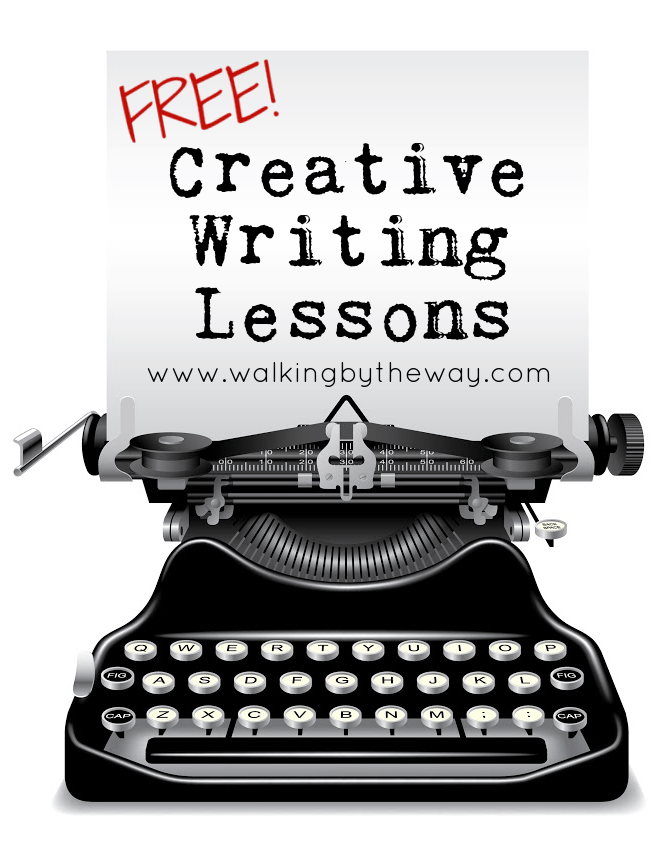
I know I throw around the word favorite all the time. But this is the truth: teaching creative writing lessons is my favorite.
I have taught creative writing enrichment for summer school students. I have taught creative writing in various homeschool settings and co-ops. I have taught big students and little students. And I love it.
Since I love to share homeschool co-op class ideas , I have compiled the creative writing lessons from a co-op class that I taught.
Creative Writing Lessons for a Homeschool Co-op Class
First, please remember that any teacher can use these creative writing lessons. You don’t need to be teaching homeschoolers. You can be a classroom teacher or a homeschool teacher at home with one student. You can even be a librarian who needs a fun program series.
Second, I used these creative writing lesson plans with upper elementary students (with maybe a few 7th graders thrown in). However, you can adapt and use them for older students or younger students!
Creative Writing Lesson Plans
Creative writing lesson one.
The first lesson focuses on cliché and metaphor. It prompts students to consider how words matter.
Grab lesson one here .
Creative Writing Lesson Two
The second lesson teaches students about sensory details: why they are important and how to include them in their writing. Students will begin using sensory details to evoke smells and sounds and sights.
Grab lesson two here.
Creative Writing Lesson Three
The third lesson introduces showing vs. telling. Students learn how to recognize authors who utilize showing, and students are able to articulate the difference between showing and telling.
Grab lesson three here.
Creative Writing Lesson Four
The fourth lesson teaches students how to capture images. We use examples of poetry and prose to discuss this important writing skill.
Grab lesson four here.
Creative Writing Lesson Five
The fifth lesson introduces the story elements of character and conflict.
Note: You may choose to split this lesson into two lessons since it covers two big elements. I only had nine weeks with my students, so I had to jam character and conflict together.
Grab lesson five here.
Creative Writing Lesson Six
The sixth lesson introduces the students to point of view and perspective. We have fun reading poems and using pictures to write descriptions from different points of view.
Grab lesson six here.
Creative Writing Lesson Seven
The seventh lesson puts everything we’ve learned together. I read the students some fractured fairy tales, and we watch some, too. Students then use the prewriting activities and their imaginations to begin drafting their own fractured fairy tales.
Grab lesson seven here.
Creative Writing Lesson Eight
The eighth lesson focuses on revision. After a mini-lesson, students partner up for peer editing.
Grab lesson eight here .
For our final class day, students bring revised work, and I host coffee shop readings. This is a memorable experience for students (and their teacher).
Creative Writing Lessons FAQ
Since posting these creative writing lessons, I have had lots of questions. I decided to compile them here in case you have the same question.
Q: What are copywork quotes? A: Copywork quotes are simply great quotes that students copy as part of their homework assignments. You can use any quotes about writing. I’ve included my favorites throughout the printable packs.
Q: Can I use this with a younger or older student? A: Absolutely! Just adapt it to meet the needs of your student.
Q: Can I use this for my library’s programming or my homeschool co-op class? A: Yes! I just ask that it not be used for profit.
Do you have any questions about teaching creative writing? What’s your biggest hang-up when it comes to teaching creative writing? I’d love to hear from you and help you solve the issue.

January 7, 2016 at 1:57 pm
Hi Theresa,
As long as you are not profitting from using them, they are yours to use! Enjoy! Wish I could be there to help facilitate all those young writers!
[…] Creative Writing Class […]
Leave a Reply Cancel reply
Your email address will not be published. Required fields are marked *
Save my name, email, and website in this browser for the next time I comment.

Creative Writing Lesson Plans: Week One
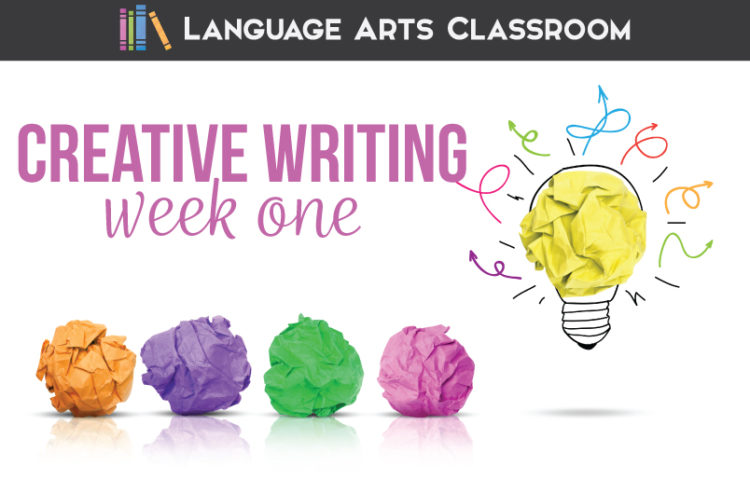
Looking for creative writing lesson plans? I am developing creative writing lesson ideas!
I’ve written and revamped my creative writing lesson plans and learned that the first week is vital in establishing a community of writers, in outlining expectations, and in working with a new class.
What are some good creative writing exercises?
Some good creative writing exercises include writing prompts, free writing, character development exercises, and fun writing games.
The first week, though, we establish trust—and then we begin powerful creative writing exercises to engage young writers and our community.
How can add encouragement in creative writing lesson plans?
I’ve found students are shy about writing creatively, about sharing pieces of themselves. A large part of the first week of class is setting the atmosphere, of showing everyone they are free to create. And! These concepts will apply to most writing lesson plans for secondary students.
Feel free to give me feedback and borrow all that you need! Below, find my detailed my day-by-day progression for creative writing lesson plans for week one.

Creative Writing Lesson Day One: Sharing my vision
Comfort matters for young writers. I’m not a huge “ice breaker” type of teacher—I build relationships slowly. Still, to get student writing, we must establish that everyone is safe to explore, to write, to error.
Here are some ideas.
Tone and attitude
For day one with any lesson plan for creative writing, I think it is important to set the tone, to immediately establish what I want from my creative writing students. And that is…
them not to write for me, but for them. I don’t want them writing what they think I want them to write.
Does that make sense? Limitations hurt young writers. My overall tone and attitude toward young writers is that we will work together, create and write together, provide feedback, and invest in ourselves. Older kiddos think that they must provide teachers with the “correct” writing. In such a course, restrictions and boundaries largely go out the window.
Plus, I specifically outline what I believe they can produce in a presentation to set people at ease.
The presentation covers expectations for the class. As the teacher, I am a sort of writing coach with ideas that will not work for everyone. Writers should explore different methods and realize what works for them. First, not everyone will appreciate every type of writing—which is fine. But as a writing community, we must accept that we may not be the target audience for every piece of work.
Therefore, respect is a large component of the class. Be sure to outline what interactions you find acceptable within your classroom community.
Next, as their writing coach, I plan to provide ideas and tools for use. Their job is to decide what tools work for their creative endeavors. My overall message is uplifting and encouraging.
Finally, when we finish, I share the presentation with students so they can consult it throughout the semester. The presentation works nicely for meet-the-teacher night, too!
After covering classroom procedures and rules, I show students a TED Talk. We watch The Danger of a Single Story by Chimamanda Adichie. My goal is to show students that I don’t have a predetermined idea concerning what they should write. This discussion takes the rest of the class period.
Establishing comfort and excitement precedents my other creative writing activities. Personalize your “vision” activities for your lessons in creative writing. Honestly, doing this pre-work builds relationships with students and creates a positive classroom atmosphere.
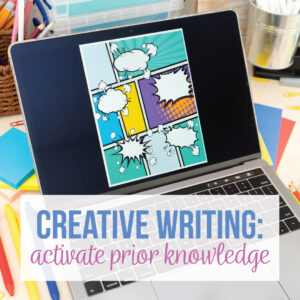
Creative Writing Lesson Day Two: Activating prior knowledge
Students possess prior knowledge concerning creative writing, but they might not consider that. Students should realize that they know what constitutes a great story. They might not realize that yet. An easy lesson plan for creative writing that will pay off later is to activate prior knowledge. Brainstorm creative, memorable, unforgettable stories with students. Share your thoughts too! You will start to build relationships with students who share the same tastes as you (and those that are completely different!).
Activation activity
During this activity, I want to see how students work together, and I want to build a rapport with students. Additionally, activating prior knowledge provides a smooth transition into other creative writing activities.
This creative writing activity is simple:
I ask students to tell me memorable stories—books, play, tv shows, movies—and I write them on the board. I add and veto as appropriate. Normally doing these classroom discussions, we dive deeper into comedies and creative nonfiction. Sometimes as we work, I ask students to research certain stories and definitions. I normally take a picture of our work so that I can build creative writing lessons from students’ interests.
This takes longer than you might think, but I like that aspect. This information can help me shape my future lessons.
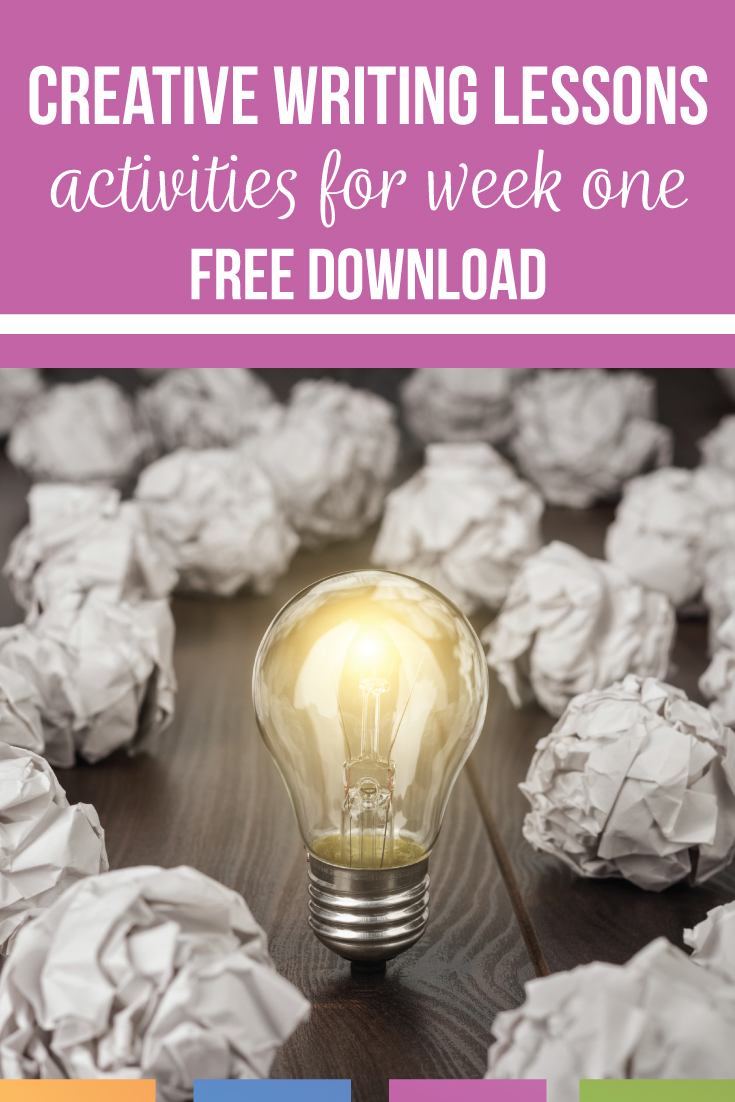
With about twenty minutes left in class, I ask students to form small groups. I want them to derive what makes these stories memorable. Since students complete group and partner activities in this class, I also watch and see how they interact.
Students often draw conclusions about what makes a story memorable:
- Realistic or true-to-life characters.
- Meaningful themes.
- Funny or sad events.
All of this information will be used later as students work on their own writing. Many times, my creative writing lessons overlap, especially concerning the feedback from young writers.
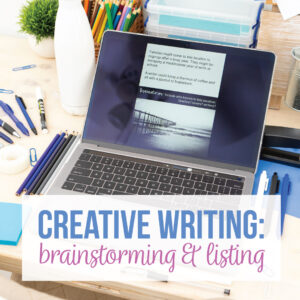
Creative Writing Lesson Day Three: Brainstorming and a graphic organizer
From building creative writing activities and implementing them, I now realize that students think they will sit and write. Ta-da! After all, this isn’t academic writing. Coaching creative writing students is part of the process.
Young writers must accept that a first draft is simply that, a first draft. Building a project requires thought and mistakes. (Any writing endeavor does, really.) Students hear ‘creative writing’ and they think… easy. Therefore, a first week lesson plan for creative writing should touch on what creativity is.
Really, creativity is everywhere. We complete a graphic organizer titled, “Where is Creativity?” Students brainstorm familiar areas that they may not realize have such pieces.
The ideas they compile stir all sorts of conversations:
- Restaurants
- Movie theaters
- Amusement parks
By completing this graphic organizer, we discuss how creativity surrounds us, how we can incorporate different pieces in our writing, and how different areas influence our processes.

Creative Writing Lesson, Days Four and Five: Creative Nonfiction
Students need practice writing, and they need to understand that they will not use every word they write. Cutting out lines is painful for them! Often, a lesson plan for creative writing involves providing time for meaningful writing.
For two days, we study and discuss creative nonfiction. Students start by reading an overview of creative nonfiction . (If you need mentor texts, that website has some as well.) When I have books available, I show the class examples of creative nonfiction.
We then continue through elements of a narrative . Classes are sometimes surprised that a narrative can be nonfiction.
The narrative writing is our first large project. As we continue, students are responsible for smaller projects as well. This keeps them writing most days.
Overall, my students and I work together during the first week of any creative writing class. I encourage them to write, and I cheer on their progress. My message to classes is that their writing has value, and an audience exists for their creations.
And that is my week one! The quick recap:
Week One Creative Writing Lesson Plans
Monday: Rules, procedures, TED Talk, discussion.
Tuesday: Prior knowledge—brainstorm the modeling of memorable stories. Draw conclusions about storytelling with anchor charts. Build community through common knowledge.
Wednesday: Graphic organizer.
Thursday and Friday: Creative nonfiction. Start narrative writing.
Students do well with this small assignment for the second week, and then we move to longer creative writing assignments . When classesexperience success with their first assignment, you can start constructive editing and revising with them as the class continues.

These creative writing activities should be easy implement and personalize for your students.
Would you like access to our free library of downloads?
Marketing Permissions
We will send you emails, but we will never sell your address.
You can change your mind at any time by clicking the unsubscribe link in the footer of any email you receive from us, or by contacting us at [email protected] . We will treat your information with respect. For more information about our privacy practices please visit our website. By clicking below, you agree that we may process your information in accordance with these terms.
We use Mailchimp as our marketing platform. By clicking below to subscribe, you acknowledge that your information will be transferred to Mailchimp for processing. Learn more about Mailchimp’s privacy practices.
Are you interested in more creative writing lesson ideas? My Facebook page has interactive educators who love to discuss creative writing for middle school and high school creative writing lesson plans. Join us!

creative writing creative writing activities
- Grades 6-12
- School Leaders
Enter Today's Teacher Appreciation Giveaway!
10 Creative Writing Activities That Help Students Tell Their Stories
Lower the stakes and help them get started.
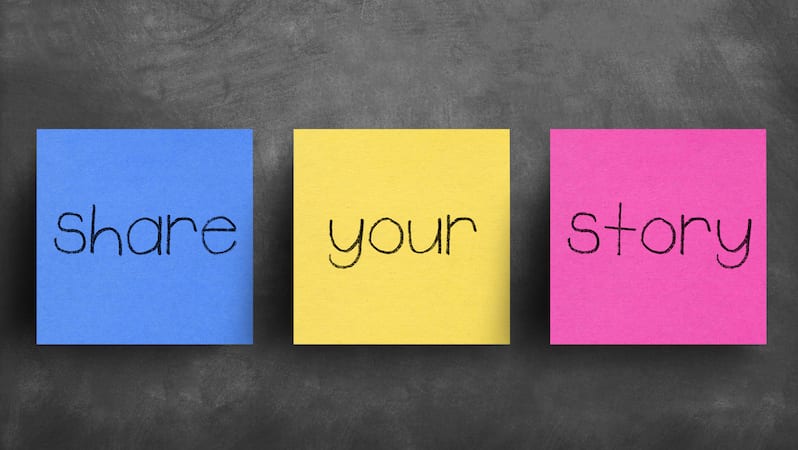
“I don’t have a story. There’s nothing interesting about my life!” Sound familiar? I don’t know a teacher who hasn’t heard students say this. When we ask our students to write about themselves, they get stuck. We know how important it is for them to tell their own stories. It’s how we explore our identities and keep our histories and cultures alive. It can even be dangerous when we don’t tell our stories (check out this Ted Talk given by novelist Chimamanda Ngozi Adichie and share it with your students for more on that). Storytelling is essential for every subject, not just English Language Arts; students dive deeper and engage when they practice thinking about how their own stories intersect with historical events, civic engagement, and the real-world implications of STEM. These 10 creative writing activities can work in every subject you teach:
Here are 10 of our favorite story telling activities that inspire students:
1. write an “i am from” poem.
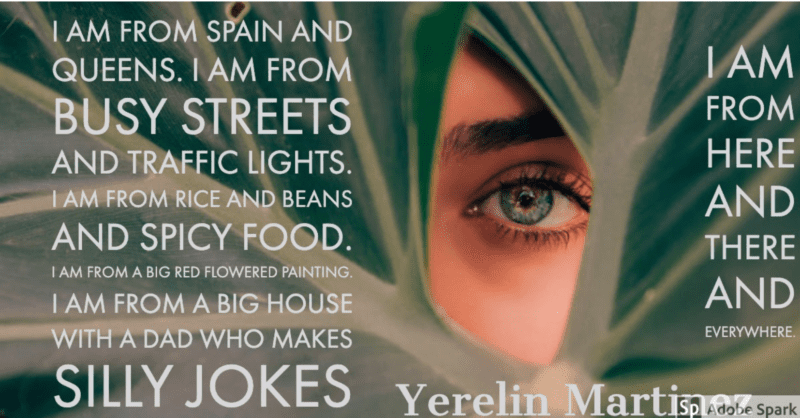
Students read the poem “I am From” by George Ella Lyon. Then, they draft a poem about their own identity in the same format Lyon used. Finally, students create a video to publish their poems. We love this one because the mentor text gives a clear structure and example that students can follow. But the end result is truly unique, just like their story.
2. Design a social media post to share an important memory
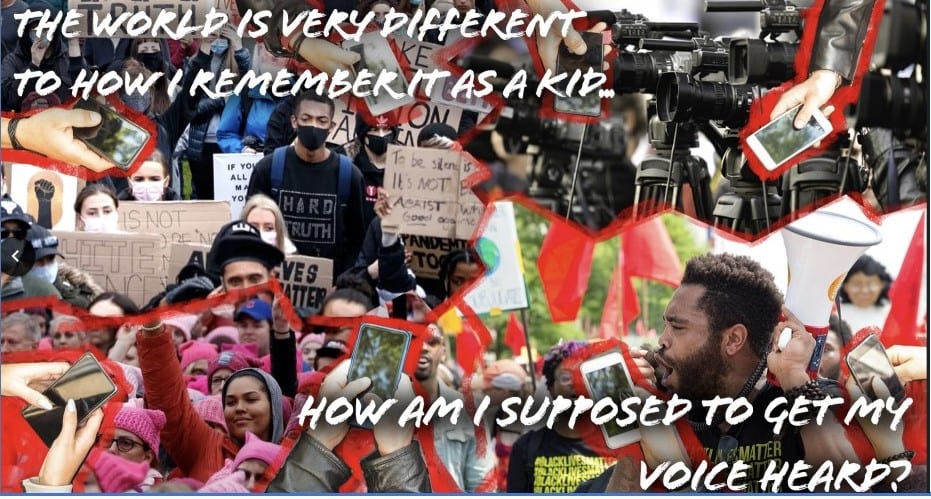
How can you use your unique perspective to tell a story? We want our students to learn that they are truly unique and have stories that only they can tell that other people want to hear or could relate to or learn from. In this activity, students watch two Pixar-in-a-Box videos on Khan Academy to learn about storytelling and perspective. Then, they identify an interesting or poignant memory and design a social media post.
3. Create an image using a line to chart an emotional journey
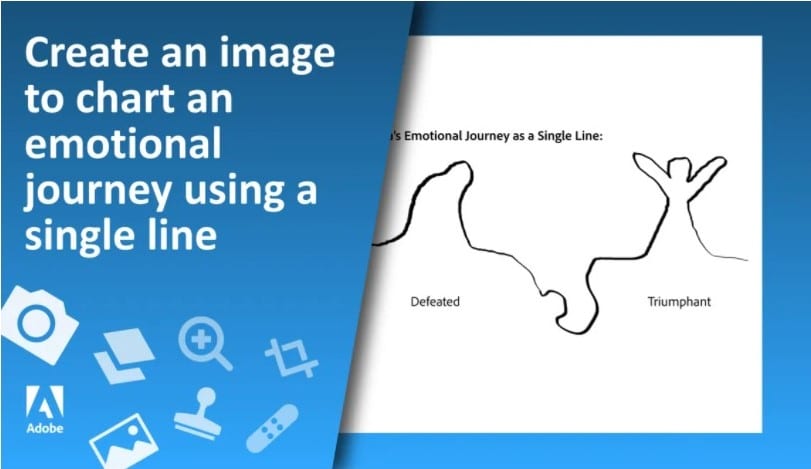
How do you show emotion using a single line? In this activity, students watch a Pixar in a Box video on Khan Academy to learn about how lines communicate character, emotion, and tension. Then they experiment with these aspects as they write their story. We love using this for pre-writing and to help students explore their story arc. Also, for students who love to draw or learn visually, this can help them get started telling their story and show them that there are many different ways to tell a story.
4. Tell the story behind your name

Sharing the story behind our name is a way to tell a story about ourselves, our culture, and our family history. And if there isn’t a story behind it, we can talk about how we feel about it and describe what it sounds like. In this activity, students use video to introduce themselves to their classmates by discussing the origin of their name. This project asks students to connect their names (and identities) to their personal and familial histories and to larger historical forces. If you’re looking for a mentor text that pairs well with this one, try “My Name” by Sandra Cisneros .
5. Develop a visual character sketch
Give students the time to create a character sketch of themselves. This will help them see how they fit into their story. In this lesson, students create a visual character sketch. They’ll treat themselves like a character and learn to see themselves objectively.
6. Create a webpage to outline the story of your movie

Building a story spine is a great way to show students how to put the parts of their story in an order that makes sense. It’s an exercise in making choices about structure. We like this activity because it gives students a chance to see different examples of structure in storytelling. Then, they consider the question: how can you use structure to set your story up for success? Finally, they design and illustrate an outline for their story.
7. Respond to a variety of writing prompts
Sometimes our students get stuck because they aren’t inspired or need a different entry point into telling their story. Give them a lot of writing prompts that they can choose from. Pass out paper and pencils. Set a timer for fifteen minutes. Then, write 3-4 writing prompts on the board. Encourage students to free-write and not worry about whether their ideas are good or right. Some of our favorite prompts to encourage students to tell their story are:
- I don’t know why I remember…
- What’s your favorite place and why?
- What objects tell the story of your life?
- What might surprise someone to learn about you?
8. Create a self-portrait exploring identity and self-expression
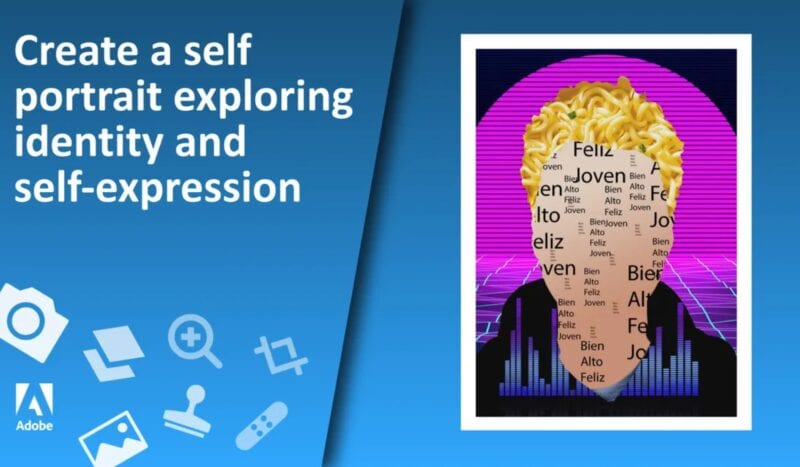
Part of what makes writing your own story so difficult for students is that they are just building their identity. In this activity, students explore how they and others define their identity. What role does identity play in determining how they are perceived and treated by others? What remains hidden and what is shown publicly?
9. Film a video to share an important story from your life

Encourage students to think about how to tell the story of a day they faced their fears. Students consider the question: How can you use different shot types to tell your story? They watch a video from Pixar in a Box on Khan Academy to learn about different camera shots and their use in storytelling. Then, they use Adobe Spark Post or Photoshop and choose three moments from their story to make into shots. We love using this to help students think about pace and perspective. Sometimes what we leave out of our story is just as important as what we include.
10. Try wild writing
Laurie Powers created a process where you read a poem and then select two lines from it. Students start their own writing with one of those lines. Anytime that they get stuck, they repeat their jump-off line again. This is a standalone activity or a daily writing warm-up, and it works with any poem. We love how it lowers the stakes. Can’t think of anything to write? Repeat the jump-off line and start again. Here are some of our favorite jump-off lines:
- The truth is…
- Some people say…
- Here’s what I forgot to tell you…
- Some questions have no answers…
- Here’s what I’m afraid to write about…
You Might Also Like
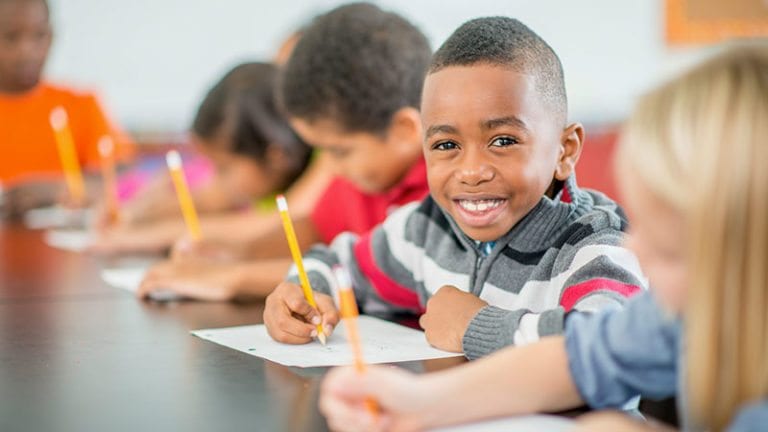
19 Simple Student Accommodations That Work
Big list of great ideas! Continue Reading
Copyright © 2024. All rights reserved. 5335 Gate Parkway, Jacksonville, FL 32256
Creative Writing Lesson Plans: From Paragraphs to Narratives
Return from Creative Writing Lesson Plans to Creative Writing Ideas and Activities
Would you prefer to share this page with others by linking to it?
- Click on the HTML link code below.
- Copy and paste it, adding a note of your own, into your blog, a Web page, forums, a blog comment, your Facebook account, or anywhere that someone would find this page valuable.
Helping You Write Across the Curriculum!
copyright 2009-2013 www.creative-writing-ideas-and-activities.com
- Writing Topics
- Writing Prompts
- Writing Ideas
- Writing Activities
- Lesson Plans
- Writing Tips
- Privacy Policy
Our Most Popular Pages
1. Teaching Resources
2. How to Write a Myth
3. February Writing Prompts
4. How to Write a Legend
5. Writing a Personal Narritive
6. Writing Fables
7. Writing Mystery Stories
8. Math Prompts
9. Science Writing Prompts
10. Elements of Persuasive Writing
Recommeded Resources:
AnyWord(TM) Spelling Practice Series!
Worksheets, games and activities to use with any spelling words. Three volumes in all!
Download yours today!
Stop Essay Pain!
LitWorks.com
Resources to help students prepare for literature examinations.
Teach Kids Drama!
Poetry Center

Five Creative Writing Lesson Plans for Middle & High School Students
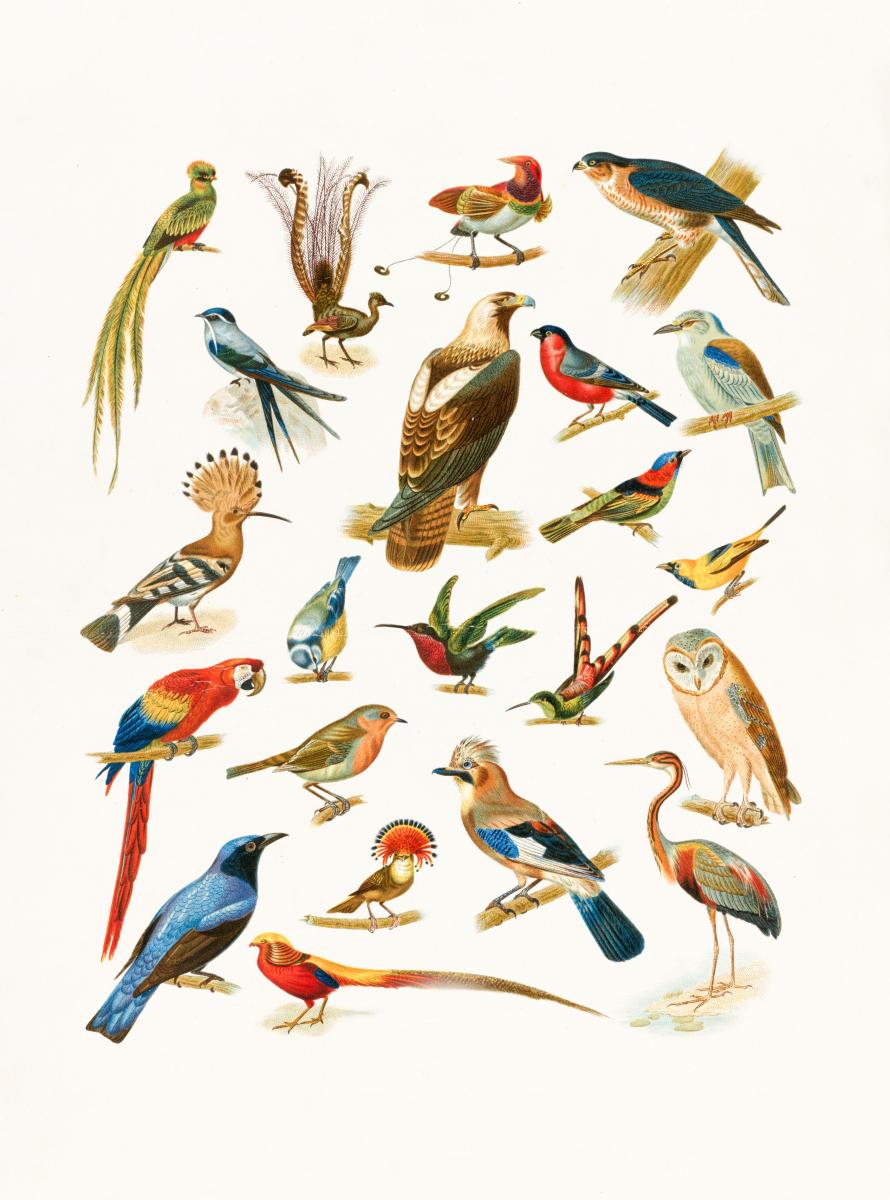
A Poem About Joy:
In this lesson plan, inspired by Ross Gay's "Sorrow Is Not My Name," Teré Fowler-Chapman asks young poets to come up with a list of things that bring them joy and then write a poem inspired by one of the items on that list. The writing exercise, which is a fantastic way to bring social-emotional learning into the classroom, is preceded by a conversation on Gay's poetics and on how joy can exist even in times of sorrow.
Personal Migrations:
Saraiya Kanning, inspired by Wang Ping's "Things We Carry on the Sea," asks young writers to, "contemplate how migration has played out in their own lives, including the lives of their families." This multi-part lesson plan includes a word association game, a discussion of Ping's poem, and a group poem in which students answer the question, "What sort of things have been carried across land, sea, or even across time?" collaboratively. After this, they write their own individual poems, using a series of questions to jump start their creativity, and then craft art pieces using popsicle sticks, pipe cleaners and/or puff paint to trace paths across the surface of their chosen canvas (Kanning used cake board!). This lesson can be shortened or spread out over class periods as part of a unit on immigration and migration.
Rare Bird Erasure:
"Erasure poems use words from another source to create a new poem," Saraiya Kanning writes in this lesson plan, which uses the field guide Rare and Elusive Birds of North America as a source text from which young writers create their own pieces (although you're welcome to use any book you'd like!). Each student receives a photocopied page from the book and goes on a "treasure hunt," selecting 5-10 words that in some way connect to one another. After creating their erasure poem, students can decorate the page with art materials to "create images, patterns, or designs around the words." This lesson plan includes a note on modifications for student with visual impairments.
Titles: Art on their Own:
So often in creative writing, the titling process is overlooked but important: as Sophie Daws says, "Writing a title can feel like putting the cherry on top of your great poem or it can feel like walking on eggshells, where the wrong title could ruin the whole poem and you just can’t come up with the right one!" This lesson plan, drawn from her high school zine residency, uses six prompts to offer a guided approach to coming up with a title for a finished project, from one that asks students to write down their favorite line to another that encourages them to think of how a title can add another tone or angle to their work.
Found Art Handmade Books:
Taylor Johnson bridges creative writing and visual art in this lesson plan, which focuses on crafting handmade books from recycled materials. Johnson suggests using everything from old postcards to yarn to insect wings to create a publication that's truly one of a kind. As far as words go, students can either add something they've previously written to their books whole cloth or cut up bits of their old writing and "remix" it. After the books are done, Johnson suggests creating a classroom library or exhibit for students to browse one another's books.
Image from the Boston Public Library.
Category:
Tags: .
- writing the community
Creative Writing Lesson Plans
Keep your class engaged with our creative writing lesson plans! Discover interactive lessons that encourage imagination and self-expression, crucial skills for effective writing. Help students write stories, poems, thank-you notes, and more such creative stuff! With clear learning objectives, fun writin ... Read more g prompts, and simple instructions, our creative writing lesson plans offer exceptional guidance to language arts teachers. Ready to build confident writers in your classroom? Start now for free!

CONTENT TYPE
- Lesson Plans
- Number Sense (24)
- Counting (9)
- Compare and Order Numbers (13)
- Place Value (9)
- Addition (42)
- Subtraction (28)
- Multiplication (29)
- Times Tables (8)
- Division (11)
- Fractions (25)
- Fractions Operations (17)
- Decimals (9)
- Geometry (5)
- Measurement (8)
- Counting Money (5)
- Algebra (6)
- Word Problems (36)
- Reading (160)
- Phonics (44)
- Books and Genres (4)
- Reading Skills (101)
- Communication Skills (13)
- Writing (10)
- Creative Writing (9)
- Grammar (93)
- Adverbs and Adjectives (15)
- Nouns and Pronouns (21)
- Prepositions and Conjunctions (12)
- Punctuation (15)
- Sentences (10)
- Verbs and Tenses (20)
- Vocabulary (22)
- Affixes (5)
- Making Connections in Reading (5)

Gratitude & Grammar Lesson Plan
Learn grammar with a twist of gratitude in this engaging lesson.

Magic of Grammar Lesson Plan
A festive journey through the world of grammar using holiday-themed activities.

Rhyme Time Rendezvous Poetry Lesson Plan
An engaging lesson plan focusing on rhymes, syllables, and poetry appreciation.

Book Builders: How-To Writing Lesson Plan
Learn to write a how-to book in this interactive lesson!

Invitation Innovation Lesson Plan
Learn to design an engaging birthday invitation in this interactive lesson.

Poetry Club Sparkle: An Interactive Learning Experience Lesson Plan
Explore the magic of poetry with our interactive lesson plan.

Poetry Playground Rhythm & Rhyme Lesson Plan
Explore the magic of poetry in this interactive lesson!

Rhythm Revelations Poetry Lesson Plan
An engaging lesson plan that explores the rhythm of poetry through singing.

Magic Wand Mystery: An Interactive Storytelling Workshop Lesson Plan
Engage in an interactive storytelling workshop with activities like narration building and rebus story.
Your one stop solution for all grade learning needs.
Creative Writing Through Wordless Picture Books

- Resources & Preparation
- Instructional Plan
- Related Resources
Wordless picture books offer a wonderful foundation for creative writing. Often, students struggle with ideas and topics for writing. This genre of books offers a platform for students to develop their writing skills. In this lesson, students are exposed to wordless picture books and begin developing story lines orally and in writing. Educators can easily incorporate various instructional strategies into students' writing, such as use of dialogue, setting development, character descriptions, sequencing of events, and story development. An online, interactive story map is used to assist students in developing story lines.
Featured Resources
Interactive Story Map : Students will love this interactive resource that helps them generate story ideas.
From Theory to Practice
- David Wiesner (author of Tuesday ) identifies one of the most valuable characteristics of wordless books-the endless possibilities for creative interpretations.
- Wordless books enhance creativity, vocabulary, and language development for readers of all ages, at all stages of cognitive development, and in all content areas.
- The creativity stimulated by wordless books encourages older students to look more closely at story details, to carefully consider all story elements, and to more clearly understand how text is organized so that a story develops.
- Through discussion and critical examination of the details of the illustrations, students wrote sentences that effectively complemented the pictures.
Common Core Standards
This resource has been aligned to the Common Core State Standards for states in which they have been adopted. If a state does not appear in the drop-down, CCSS alignments are forthcoming.
State Standards
This lesson has been aligned to standards in the following states. If a state does not appear in the drop-down, standard alignments are not currently available for that state.
NCTE/IRA National Standards for the English Language Arts
- 1. Students read a wide range of print and nonprint texts to build an understanding of texts, of themselves, and of the cultures of the United States and the world; to acquire new information; to respond to the needs and demands of society and the workplace; and for personal fulfillment. Among these texts are fiction and nonfiction, classic and contemporary works.
- 3. Students apply a wide range of strategies to comprehend, interpret, evaluate, and appreciate texts. They draw on their prior experience, their interactions with other readers and writers, their knowledge of word meaning and of other texts, their word identification strategies, and their understanding of textual features (e.g., sound-letter correspondence, sentence structure, context, graphics).
- 6. Students apply knowledge of language structure, language conventions (e.g., spelling and punctuation), media techniques, figurative language, and genre to create, critique, and discuss print and nonprint texts.
- 11. Students participate as knowledgeable, reflective, creative, and critical members of a variety of literacy communities.
Materials and Technology
- You Can't Take a Balloon Into the National Gallery by Weitzmann and Glasser (Dial Books for Young Readers, 2000)
- Sticky notes (3 X 5 size, lined is preferred)
- Student response journals
- Various wordless picture books: Wordless Picture Books (Reading Rockets) and Wordless Picture Books (Book Riot)
Peer Critique Rubric
Preparation
Student objectives.
Students will
- Explore various wordless picture books
- Develop oral story lines for wordless picture books
- Develop written story lines for wordless picture books
- Critique story lines developed by peers
Opening activity
Read a wordless picture book to the class by developing a story line to go along with the pictures. After reading, ask students if they would have created a different story for the book. Reread the same book asking students to volunteer to develop a story line for each page. Explain how everyone can have a different interpretation of a book.
Paired reading
Group students in pairs to select and read a wordless picture book together. Students should have the opportunity to create their own story line for the book and tell the story to their partner.
Small-group activity
Gather three to four students in a small group to develop a story for the book You Can't Take a Balloon Into the National Gallery. Explain that the story line should be created as a group. Each group should read through the book first, discuss ideas, and then develop a story line to go along with the illustrations. The text for each page should be written on sticky notes and placed on the coordinating pages of the book.
Whole-class discussion
Invite each group to read aloud their original story for the book You Can't Take a Balloon Into the National Gallery. Discuss the similarities and differences between each group's interpretation of the story. During the discussion, help students identify the setting, main character, conflict, and resolution, and model how to use the interactive Story Map tool.

Response journal activity
Have students complete a journal entry in response to the whole-class discussion about story lines for You Can't Take a Balloon Into the National Gallery. Ask them the following questions:
- Which story line was your favorite?
- Why was it your favorite?
- What made it enjoyable?
Independent work
Students select a wordless picture book from the classroom library to read and develop an original story line. Using the interactive Story Map tool, students begin to write their story line by identifying the setting, main character, conflict, and resolution. Once students complete the online Story Map, each map should be printed and used as a guide to further develop their story. Stories should incorporate elements of writing that include, but are not limited to:
- Use of dialogue
- Setting development
- Character descriptions
- Sequencing of events
- Story development
Pair-and-share conference
Students share their story lines with another student for critique. Comments and suggestions are provided for further story development. Students use a Peer Critique Rubric to complete this task.
Independent revision
Any revisions that are necessary are made based on the pair-and-share conference.
Whole-class sharing
Students read their original story to the class.
How does the museum on the website differ from the museum presented in the book? What does the author do well in portraying the museum? What is the most realistic illustration or part in the book?
- Have students create Character Trading Cards for the characters in the stories they have written. These can have multiple applications - for example, students can exchange them and write their own original stories incorporating each other's characters or they can use them as a tool to help them revise their stories.
Student Assessment / Reflections
- Teacher observation of student participation in whole-class and small-group activities
- Journal response entries
- Calendar Activities
- Student Interactives
The Story Map interactive is designed to assist students in prewriting and postreading activities by focusing on the key elements of character, setting, conflict, and resolution.
Add new comment
- Print this resource
Explore Resources by Grade
- Kindergarten K
- Varsity Tutors
- K-5 Subjects
- Study Skills
- All AP Subjects
- AP Calculus
- AP Chemistry
- AP Computer Science
- AP Human Geography
- AP Macroeconomics
- AP Microeconomics
- AP Statistics
- AP US History
- AP World History
- All Business
- Business Calculus
- Microsoft Excel
- Supply Chain Management
- All Humanities
- Essay Editing
- All Languages
- Mandarin Chinese
- Portuguese Chinese
- Sign Language
- All Learning Differences
- Learning Disabilities
- Special Education
- College Math
- Common Core Math
- Elementary School Math
- High School Math
- Middle School Math
- Pre-Calculus
- Trigonometry
- All Science
- Organic Chemistry
- Physical Chemistry
- All Engineering
- Chemical Engineering
- Civil Engineering
- Computer Science
- Electrical Engineering
- Industrial Engineering
- Materials Science & Engineering
- Mechanical Engineering
- Thermodynamics
- Biostatistics
- College Essays
- High School
- College & Adult
- 1-on-1 Private Tutoring
- Online Tutoring
- Instant Tutoring
- Pricing Info
- All AP Exams
- ACT Tutoring
- ACT Reading
- ACT Science
- ACT Writing
- SAT Tutoring
- SAT Reading
- SAT Writing
- GRE Tutoring
- NCLEX Tutoring
- Real Estate License
- And more...
- StarCourses
- Beginners Coding
- Early Childhood
- For Schools Overview
- High-Dosage Tutoring
- Free 24/7 Tutoring & Classes
- Live Learning Platform
- Learning Outcomes
- About The Tutors
- Talk with Our Team
- Reviews & Testimonials
- Press & Media Coverage
- Tutor/Instructor Jobs
- Corporate Solutions
- About Nerdy
- Become a Tutor

- Book Reports
- Children’s Literature
- Interdisciplinary
- Just for Fun
- Literature (Prose)
- Professional Resources
- Reading/Literacy
- Shakespeare
- Study Guides
- Technology Integration
- Young Adult Literature
Creative Writing
15 Classified Ads We Hope Had Happy Endings Writing prompt: choose one of these historical ads and construct a narrative that supports it. Include characters, location, and other necessary details. (Teachers may wish to check the ads for appropriateness.)
20 Mystical Bridges That Will Take You To Another World Creative writing prompt: "I walked across the bridge and ..." The photographs of real bridges on this page are astonishingly beautiful. However, the page also carries ads that may not be appropriate for the classroom. Consider copying the photographs into a new file for classroom use.
27 Magical Paths Begging To Be Walked Photographs of beautiful paths all over the world, showing a variety of seasons and geography, just waiting to inspire a poem or serve as the setting for a short story. Note: this page carries ads that may not be appropriate for the classroom. Consider copying the photographs into a new file for classroom use.
The 100-Word Challenge In this activity students respond to a prompt using not more than 100 words. Writing is posted on a class blog, where responses are invited. The activity encourages regular writing for an authentic audience. It's designed for students 16 and under.
Adding Emotions to your Story A good lesson on adding detail, "exploding" an incident, and "show, don't tell." It includes handouts and is designed for grades 3-5.
After the First Draft: 30 Fast, Easy Writing Tips for the Second Draft This 37-page document is designed for writers of novels, but many of the tips apply equally to writers of short stories. Clear, simple, and easy to read, appropriate for 5th or 6th grade (in places) and up. Adobe Reader required for access.
All Together Now: Collaborations in Poetry Writing Students write a line of poetry in response to something the teacher reads. Their lines, together, form a poem. This unit is designed for grades K-2.
Bernadette Mayer's List of Journal Ideas A list of journal topics that will work on multiple grade levels. Scroll down for a list of "Writing Experiments" that will work well in a creative writing unit.
The Book of Butterflies by Michael Leunig (Scroll down on the page.) This short (1:06) video explores the question "What happens when a book comes to life?" It will work well on almost any grade level.
By the Old Mill Stream A creative writing prompt, differentiated for elementary and middle and high school students. Students begin writing a narrative. In the second part of the prompt, they write a description.
Calling on the Muse: Exercises to Unlock the Poet Within From Education World.
Can You Haiku? from EdSitement Complete lesson plans for writing haiku, links to additional material.
Character Name Generator Choose ethnicity, decade of birth, and gender, and this site will generate an appropriate name and a possible character description.
Characterization in Literature and Theater Students explore various methods authors use to create effective characters. Students will consider what makes a character believable and create their own characterizations. They will also write a short script using the characters they created and act out the script.
The Clues to a Great Story One-page handout with 5 essential elements for good storytelling. Uses "The Ugly Duckling" and more contemporary stories for examples.
The Color of Love In this lesson students will be invited to reflect on a variety of colors and the pleasurable things that those colors invoke. They then will write a poem about someone they love following Barbara Joosse's style in I Love You the Purplest .
Creating Characters Students examine character as a significant element of fiction. They learn several methods of characterization, identify and critique these methods in well-known works of fiction, and use the methods in works of their own. Students also identify, examine, evaluate, and use the elements dialogue and point of view as methods of characterization.
Creative State of Mind: Focusing on the Writing Process In this lesson, students examine the lyrics of rap artist Jay-Z for literary elements including rhyme, metaphor, puns and allusions, then consider what he says about his own writing process. Finally, they analyze additional lyrics and apply lessons from Jay-Z's process to their own reading and writing.
The Cutting Edge: Exploring How Editing Affects an Author's Work Students examine the writing of short-story author Raymond Carver as well as their own writing to explore how editing can affect the text, content and context of an author's work.
How to Effectively Teach Creative Writing in Elementary
Today let’s discuss how to effectively teach creative writing at the elementary level. Creative writing is such an important writing skill to teach students from a young age. Young writers need to understand the concept of creative writing as using their imagination to express themselves freely through words.
It’s not just about proper grammar and spelling (though those are important too!) , but rather about sparking their creativity , allowing them to dream up unique characters , exciting adventures, and incredible worlds. By nurturing their storytelling abilities early on, we’re not just helping them become better writers, but also fostering their confidence, encouraging self-expression, and igniting a lifelong love for writing. So, let’s dive into some strategies and tips to make your creative writing lesson plans a hit in your elementary classroom!
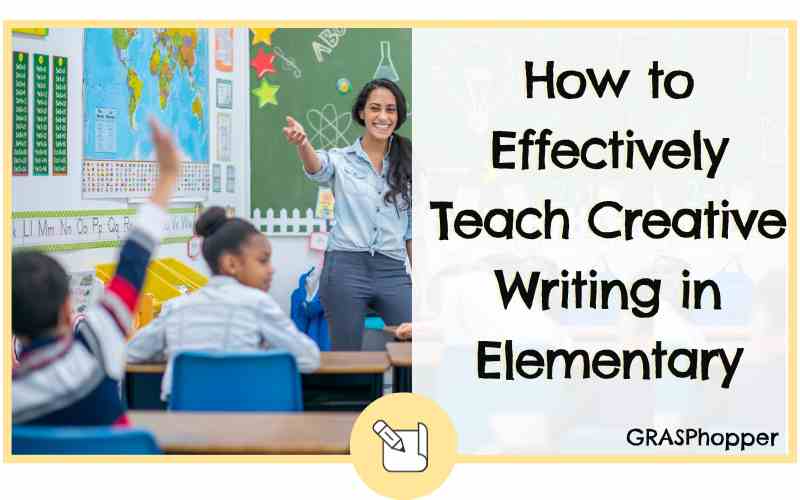
What is Creative Writing?
Creative writing is essentially writing in which the author uses his or her imagination to create a story. Creative writing in simple terms refers to the process of expressing thoughts, ideas and stories in a unique and imaginative way.
It’s about letting children’s minds wander freely, encouraging them to use their imagination to create characters, settings, and plots. Creative writing isn’t just about grammar and spelling; it’s about fostering a love for storytelling, allowing kids to explore their creativity, and helping them find their voice through words on paper. It’s a journey that encourages self-expression, builds confidence, and nurtures a lifelong appreciation for writing. The whole purpose of creative writing is to think outside the box and stray from traditional structures and norms.
Creative writing falls under one of the 5 categories of writing but it also combines a lot of these styles together:
- Narrative Writing
- Descriptive Writing
- Persuasive Writing
- Expository Writing
- Creative Writing
Creative Writing Lesson Plans Don’t Have to Be Difficult
Finding creative ways for students to write using their imaginations doesn’t have to be difficult. No matter the grade level, creative writing lessons should offer plenty of opportunities for students to tell their point of view on a subject. Don’t let creating lesson plans for creative writing be a headache! It’s all about giving kids the chance to let loose and share their thoughts in their own special way.
Whether they’re in 2nd grade, 3rd grade, or 5th grade, the key is to let their imagination run wild. Get them talking about what interests them, throw in some fun prompts, and watch the magic happen! Mix things up with different writing styles – stories, poems, even real-life tales. Make it a safe space where they feel free to jot down whatever comes to mind. By balancing a bit of structure with loads of creative freedom, teaching creative writing becomes a blast for both the teachers and the students!

Here’s How to Teach a Creative Writing Activity to Elementary Students:
1. start with creative writing prompts.
One of the first activities you can try is using writing prompts with students. Writing prompts are a great tool to get students’ brain juices flowing, no matter if they are elementary, middle school, or high school students! Coming up with writing topics for younger students can be especially challenging sometimes.
Inside the How to Write a Paragraph Year-Long Bundle there are specific writing prompts that are scaffolded and differentiated to meet all learner’s needs. You will find everything you need inside this resource to help your students who struggle with writing understand how to write a paragraph all YEAR LONG … trust us! It allows for easy planning for your writing lessons because it’s got different seasonal writing resources and prompts inside no matter what time of year it is. These are the perfect place to start to get your students writing based on themes.
Once they are comfortable in this category, then it’s time to actually get them to come up with some of their own ideas to write about now (after all that is the ENTIRE point of a creative writing lesson!)
Try with these juicy writing prompts below to help get your student’s creativity flowing if they need help coming up with a topic to write about :
- Personal memories: “Tell about someone who taught you something really important.”
- Imaginative scenarios: “Let’s create a wild story set in a world where anything goes!”
- Prompts based on a familiar mentor text: “What if your favorite book ended differently? Give it a new twist!”
- Lead-in sentences: “I saw myself in the mirror and couldn’t believe what I saw. Overnight, I…”
- Fascinating or thought-provoking images with a directive: “Who do you think calls this log cabin home? Tell us their story and what they’re up to!”
2. Break Down the Prompts Together
Do NOT rush this next step! We need to make sure our students are coming up with unique and creative writing ideas. During this first week’s lesson plan, you want to make sure students know exactly what they are getting themselves into with the creative writing process. Make it known that these prompts above are to help guide them and their imagination. Help to break down what each prompt is asking/ looking for:
For example, if the prompt says “I saw myself in the mirror and couldn’t believe what I saw. Overnight, I…,” then what questions should the students be asking?
Hopefully, they will tell you they want to know what they look like in the mirror right now.
Then you can have students think of 5 possible situations for what happened and how they look.
3. Do a 5 Minute “Free Write Brain Dump”
During the next step of a creative writing lesson plan, encourage students to do a brain dump in their writing journals on all of their prior knowledge on the subject that they will be writing about. This lets you know a couple of things as the teacher: Do they have their own experience on this topic and enough background knowledge? Does the subject areas that they are free-writing about make sense for the creative writing topic? This should only take about 5 minutes and you are NOT worried about spelling or grammar during this step.
For example: if they are planning to write about the solar system but they don’t have much to say during this free write brain dump, this is where you may want to incorporate a mini lesson or guided conference with you to make sure they are picking a topic that they have a lot of background knowledge about or can at least figure out where to find the answers they might need for their writing.
The “free write brain dump” is helpful for students to see a couple of things- okay I know enough information about this topic and am ready to organize my thoughts OR I had a hard time just coming up with random thoughts to write about…maybe I need a need a new topic. It will truly help decide their confidence factor for this assignment.

4. Start Your Planning Process
The next step in your creative writing unit should be having students take their decided-upon creative writing topic and organize their thoughts and ideas. This step is super important because you want the information to be in the students’ own writing but you also want to make sure they have a plan for how to get their point across. Your stronger writers may be ready to go but some may need a bit more structure set up to help them.
There are a couple of different ways they can organize their ideas:
Use Graphic Organizers
Graphic organizers are the perfect thing to use if students want to stick with a paragraph-type writing structure. For your lower writers, this might be the way to go because graphic organizers make planning a lot easier and the structure makes it super easy to follow. Graphic organizers also help break down the writing process into chunks so it doesn’t feel like such a difficult task to students who may struggle more with their writing skills or for ESL students.
Character Development Worksheets
Provide worksheets that prompt students to describe the characters in detail that they want in their story. Include sections for physical appearance, personality traits, motivations, and character arcs. This helps students develop well-rounded characters before they start writing.
Peer Brainstorming
Organize small group brainstorming sessions where students can share their ideas and receive feedback from their peers. This way can totally help students polish up their ideas and come up with fresh new ones for their creative writing.
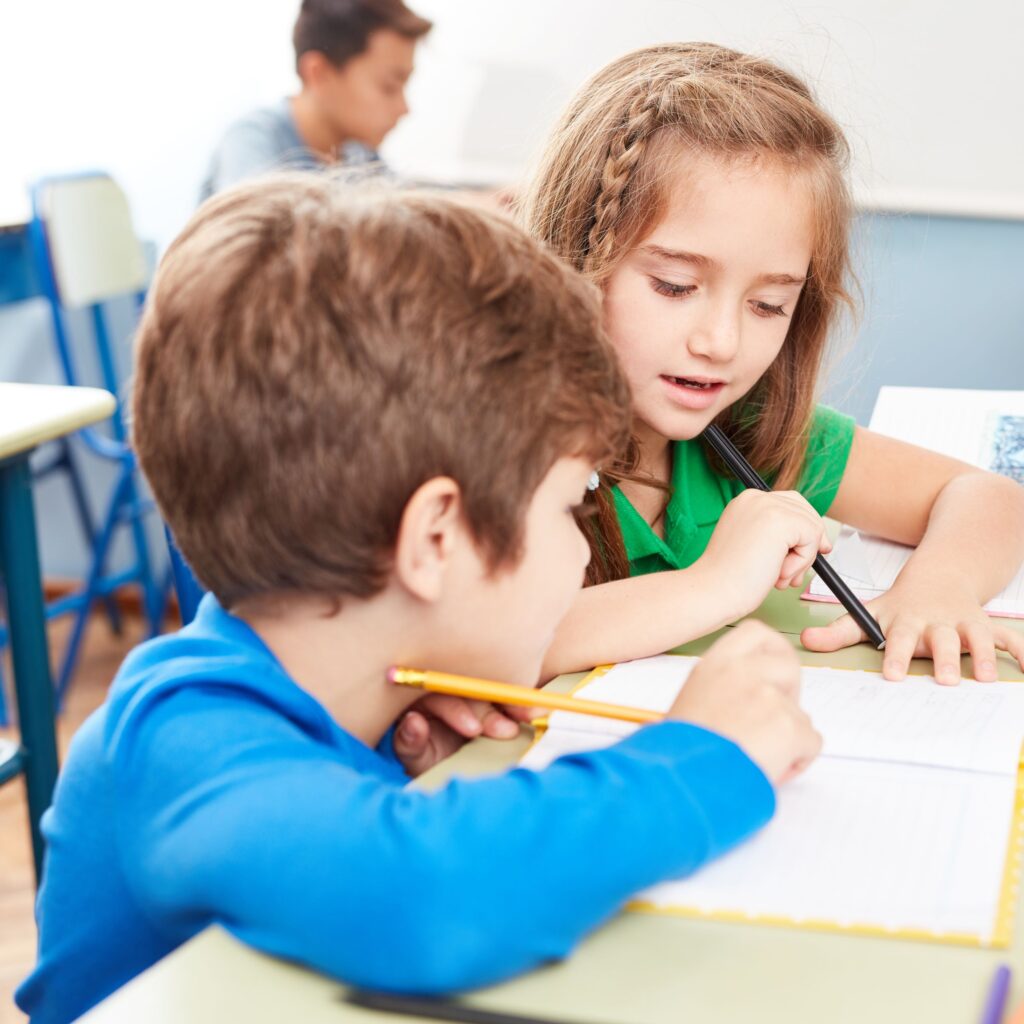
Story Boarding
Encourage students to create a visual storyboard for their story. They can draw a series of pictures or scenes that outline the plot, helping them visualize the sequence of events in their narrative. We really love this idea for planning for students who are learning English as a second language and students who have more difficulties communicating their thoughts out loud.
Voice Recording
Finally, one last idea: If your students are feeling unsure about writing things down, suggest they talk it out and record their thoughts on a device such as a classroom iPad.
They might be amazed at how easily their spoken words turn into great written stuff on the page! This is another favorite of ours for those students who struggle with getting their thoughts on paper or are learning English as a second language.
During the planning phase , it is a good time to take the opportunity to do any mini lessons you feel needed with students on any of the skills above.
5. Write the Rough Draft
Next is taking the creative narrative and putting it into a rough draft version using their planning method. It’s time for them to start coming up with their own creative short story. Do they have a main character? Is there a problem and solution? Does the writing make sense? After the rough draft, it can be super beneficial to meet with students individually or in small groups to give feedback before they move forward on the final copy.
Word of advice: Don’t worry about spelling or grammar too much in the rough draft phase! Just help students get their thoughts out onto paper!
6. Time To Write the Final Draft
As the creative writing journey nears its conclusion, it’s time to guide your students toward the crucial phase of crafting their final drafts. This stage marks a shift towards independent work, where students take ownership of refining their narratives. Encourage them to enrich their stories with vibrant sensory details to help bring the writing to life.
This isn’t just about polishing; it’s about infusing their words with emotions and imagination. The final draft represents all of their hard work! Make sure you help them reach their fullest potential with their creative writing and storytelling skills!
A Final Word on Teaching Creative Writing to Elementary Students
When planning your creative writing lesson plans for the school year, it’s best to think about the overall entire writing process. For students that you KNOW creative writing will be a challenge for, take some time during English language arts sessions and work with them on the simple structures of writing to help build their confidence. If they struggle with the mechanics and confidence to write, they honestly may not be ready for the creative writing process just yet. Use the resource below to help them refine their writing skills so that all of your students can be a confident and creative writer!

How do you feel about creative writing lesson plans?
You might also like:.
FREE Differentiated Creative Writing Prompts for Fall
Excuse our digital dust! We’re busy renovating this website to make it even more fabulous. Stay tuned!
- Read more about: Writing
You might also like...
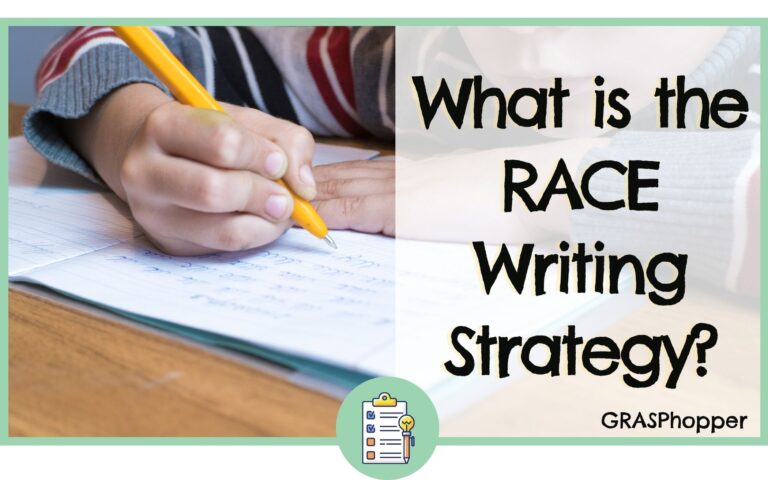
What is the RACE Writing Strategy?

The Best Paragraph Writing Worksheets for 5th Grade
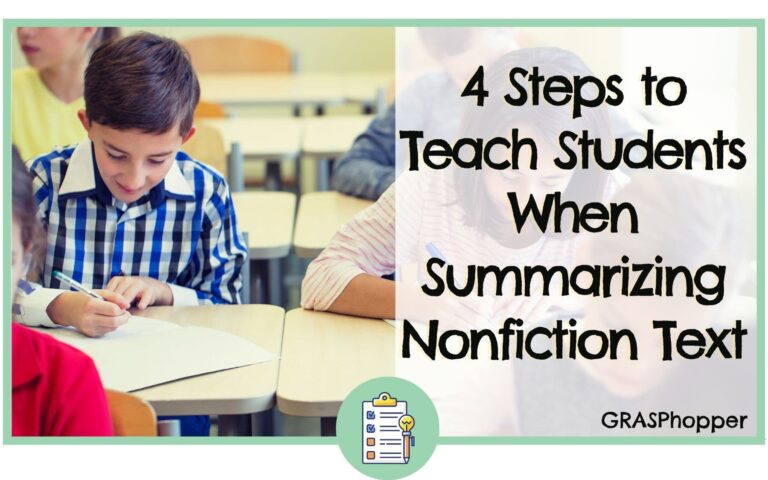
4 Steps to Teach Students When Summarizing Nonfiction Text
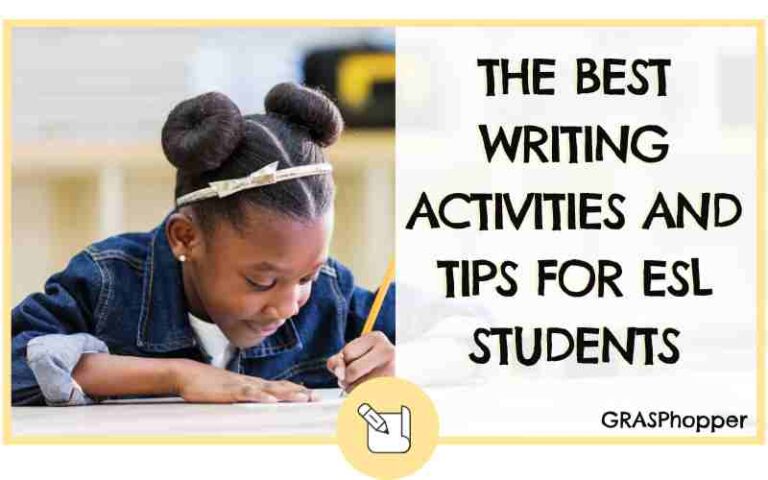
The Best Writing Activities and Tips for ESL Students
Teach smarter, not harder join the newsletter.
Transform your teaching with our teaching tips, resources, and freebies delivered straight to your inbox!

The Goodies
© GRASPhopper Learning • Website by KristenDoyle.co
- Try for free
7th Grade Creative Writing Lesson Plans
- Most Popular
- Most Recent


Making English Fun
100 Creative Writing Prompts for High School Students
Creative writing is an essential skill for high school students, as it fosters imagination, enhances writing proficiency, and encourages critical thinking.
Whether you’re preparing for college applications or simply looking to improve your writing, creative writing prompts can serve as a valuable tool to inspire and guide you.
Below are 100 creative writing prompts designed specifically for high school students, covering a range of themes and topics to spark your creativity and help you develop your unique voice.
You can also download these from the link just below and at the end of the article
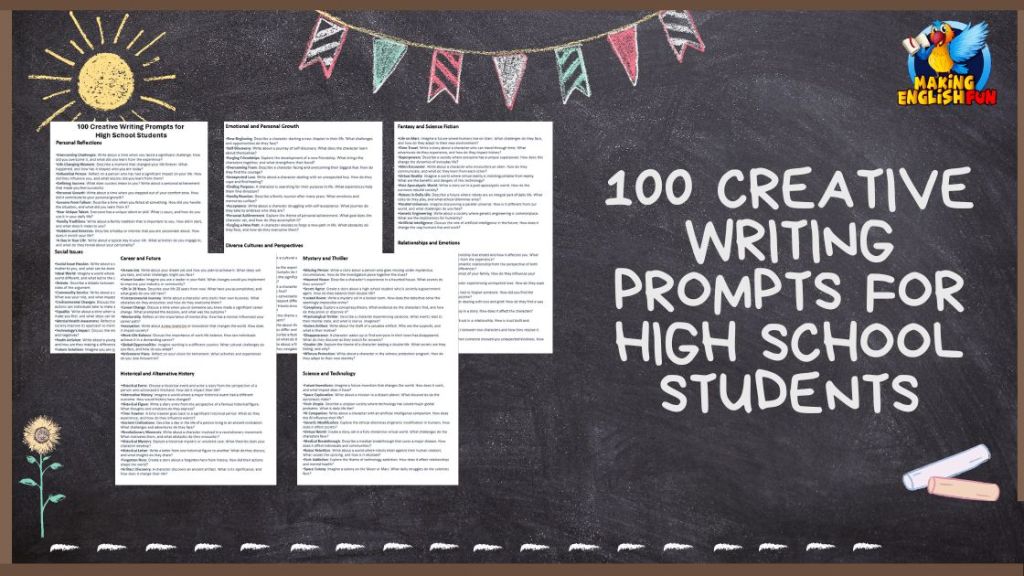
What are Creative Writing Prompts?
Creative writing prompts are short, open-ended questions or statements designed to inspire creative thought and stimulate the imagination.
They serve as a starting point for writing, helping writers to overcome writer’s block, generate new ideas, and explore different genres and styles.
They are widely used in educational settings, workshops, and personal writing practices to encourage regular writing habits and enhance writing skills.
Examples of Creative Writing Prompts:
- Character-Based Prompts : “Describe a day in the life of a superhero living a mundane life.”
- Setting-Based Prompts : “Write about a secret garden that only appears at midnight.”
- Plot-Based Prompts : “Your character discovers an old letter in a library book. What does it say?”
- Theme-Based Prompts : “Explore the concept of time travel and its impact on personal identity.”
How to Use Creative Writing Prompts
Using creative writing prompts effectively involves a few simple steps to get the most out of them:
- Choose a Prompt : Select a prompt that sparks your interest or curiosity. It could be related to a topic you enjoy or something completely new to challenge yourself.
- Set a Timer : Give yourself a specific amount of time to write, such as 15-30 minutes. This helps to keep you focused and prevents overthinking.
- Free Write : Start writing without worrying about grammar, punctuation, or structure. Let your thoughts flow freely and see where the prompt takes you.
- Expand and Edit : After your free-writing session, review what you’ve written. Identify interesting ideas or themes that you can expand upon. Edit and refine your work to improve clarity and coherence.
- Share and Reflect : Share your writing with others if you feel comfortable. Feedback can provide new perspectives and ideas. Reflect on the writing process and what you learned from it.
Tips for Using Prompts:
- Be Open-Minded : Don’t limit yourself to the first idea that comes to mind. Explore different angles and perspectives.
- Stay Consistent : Use prompts regularly to build a writing habit. Even short, daily writing sessions can be beneficial.
- Combine Prompts : Mix and match different prompts to create more complex and intriguing stories .
- Personalize : Adapt prompts to better suit your interests or experiences. Personal connections can enhance creativity and engagement.
Benefits of Creative Writing Prompts:
- Overcome Writer’s Block : Prompts provide a starting point, making it easier to begin writing.
- Inspire Creativity : They encourage thinking outside the box and exploring new ideas.
- Improve Writing Skills : Regular use of prompts helps improve various aspects of writing, such as vocabulary, style, and structure.
- Boost Confidence : Successfully completing prompts can build confidence and motivation to write more.
We also have Creative writing prompt s for middle and grade school students here on the site as well.
We have split these into topics to make them more digestible.
Creative Writing Prompts: Personal Reflections
- Overcoming Challenges : Write about a time when you faced a significant challenge . How did you overcome it, and what did you learn from the experience?
- Life-Changing Moment : Describe a moment that changed your life forever. What happened, and how has it shaped who you are today?
- Influential Person : Reflect on a person who has had a significant impact on your life. How did they influence you, and what lessons did you learn from them?
- Defining Success : What does success mean to you? Write about a personal achievement that made you feel successful.
- Personal Growth : Write about a time when you stepped out of your comfort zone. How did it contribute to your personal growth?
- Lessons from Failure : Describe a time when you failed at something. How did you handle the situation, and what did you learn from it?
- Your Unique Talent : Everyone has a unique talent or skill. What is yours, and how do you use it in your daily life?
- Family Traditions : Write about a family tradition that is important to you. How did it start, and what does it mean to you?
- Hobbies and Interests : Describe a hobby or interest that you are passionate about. How does it enrich your life?
- A Day in Your Life : Write about a typical day in your life. What activities do you engage in, and what do they reveal about your personality?
Creative Writing Prompts: Social Issues
- Social Issue Passion : Write about a social issue that you are passionate about. Why does it matter to you, and what can be done to address it?
- Ideal World : Imagine a world where a significant social issue has been resolved. How is the world different, and what led to the change?
- Debate : Describe a debate between two characters on a current social issue. Present both sides of the argument.
- Community Service : Write about a community service project you have been involved in. What was your role, and what impact did it have?
- Environmental Changes : Discuss the importance of environmental conservation. What actions can individuals take to make a difference?
- Equality : Write about a time when you witnessed or experienced inequality. How did it make you feel, and what steps can be taken to promote equality?
- Mental Health Awareness : Reflect on the importance of mental health awareness. How can society improve its approach to mental health?
- Technology’s Impact : Discuss the impact of technology on society. What are the positives and negatives?
- Youth Activism : Write about a young activist who inspires you. What cause do they support, and how are they making a difference?
- Future Solutions : Imagine you are in a position to solve a major social issue. What steps would you take, and how would you ensure lasting change?
Creative Writing Prompts: Fantasy and Science Fiction
- Life on Mars : Imagine a future where humans live on Mars. What challenges do they face, and how do they adapt to their new environment?
- Time Travel : Write a story about a character who can travel through time. What adventures do they experience, and how do they impact history?
- Superpowers : Describe a society where everyone has a unique superpower. How does this change the dynamics of everyday life?
- Alien Encounter : Write about a character who encounters an alien. How do they communicate, and what do they learn from each other?
- Virtual Reality : Imagine a world where virtual reality is indistinguishable from reality. What are the benefits and dangers of this technology?
- Post-Apocalyptic World : Write a story set in a post-apocalyptic world. How do the survivors rebuild society?
- Robots in Daily Life : Describe a future where robots are an integral part of daily life. What roles do they play, and what ethical dilemmas arise?
- Parallel Universes : Imagine discovering a parallel universe. How is it different from our world, and what challenges do you face?
- Genetic Engineering : Write about a society where genetic engineering is commonplace. What are the implications for humanity?
- Artificial Intelligence : Discuss the role of artificial intelligence in the future. How does it change the way humans live and work?
Creative Writing Prompts: Relationships and Emotions
- Ending Friendships : Write about a friendship that ended and how it affected you. What caused the rift, and what did you learn from the experience?
- Romantic Relationships : Describe a romantic relationship from the perspective of both partners. How do they navigate their differences?
- Family Dynamics : Reflect on the dynamics of your family. How do they influence your identity and choices?
- Unrequited Love : Write about a character experiencing unrequited love. How do they cope with their feelings?
- Forgiveness : Discuss a time when you had to forgive someone. How did you find the strength to do so, and what was the outcome?
- Loss and Grief : Write about a character dealing with loss and grief. How do they find a way to move forward?
- Jealousy : Explore the theme of jealousy in a story. How does it affect the characters’ relationships?
- Trust : Write about the importance of trust in a relationship. How is trust built and maintained?
- Conflict Resolution : Describe a conflict between two characters and how they resolve it. What compromises are made?
- Acts of Kindness : Reflect on a time when someone showed you unexpected kindness. How did it impact you?
Creative Writing Prompts: Career and Future
- Dream Job : Write about your dream job and how you plan to achieve it. What steps will you take, and what challenges might you face?
- Future Leader : Imagine you are a leader in your field. What changes would you implement to improve your industry or community?
- Life in 20 Years : Describe your life 20 years from now. What have you accomplished, and what goals do you still have?
- Entrepreneurial Journey : Write about a character who starts their own business. What obstacles do they encounter, and how do they overcome them?
- Career Change : Discuss a time when you or someone you know made a significant career change. What prompted the decision, and what was the outcome?
- Mentorship : Reflect on the importance of mentorship. How has a mentor influenced your career path?
- Innovation : Write about a new invention or innovation that changes the world. How does it impact society?
- Work-Life Balance : Discuss the importance of work-life balance. How can individuals achieve it in a demanding career?
- Global Opportunities : Imagine working in a different country. What cultural challenges do you face, and how do you adapt?
- Retirement Plans : Reflect on your vision for retirement. What activities and experiences do you look forward to?
Creative Writing Prompts: Historical and Alternative History
- Historical Event : Choose a historical event and write a story from the perspective of a person who witnessed it firsthand. How did it impact their life?
- Alternative History : Imagine a world where a major historical event had a different outcome. How would history have changed?
- Historical Figure : Write a diary entry from the perspective of a famous historical figure. What thoughts and emotions do they express?
- Time Traveler : A time traveler goes back to a significant historical period. What do they experience, and how do they influence events?
- Ancient Civilizations : Describe a day in the life of a person living in an ancient civilization. What challenges and adventures do they face?
- Revolutionary Moments : Write about a character involved in a revolutionary movement. What motivates them, and what obstacles do they encounter?
- Historical Mystery : Explore a historical mystery or unsolved case. What theories does your character develop?
- Historical Letter : Write a letter from one historical figure to another. What do they discuss, and what insights do they share?
- Forgotten Hero : Create a story about a forgotten hero from history. How did their actions shape the world?
- Artifact Discovery : A character discovers an ancient artifact. What is its significance, and how does it change their life?
Creative Writing Prompts: Science and Technology
- Future Inventions : Imagine a future invention that changes the world. How does it work, and what impact does it have?
- Space Exploration : Write about a mission to a distant planet. What discoveries do the astronauts make?
- Tech Utopia : Describe a utopian society where technology has solved major global problems. What is daily life like?
- AI Companion : Write about a character with an artificial intelligence companion. How does the AI influence their life?
- Genetic Modification : Explore the ethical dilemmas of genetic modification in humans. How does it affect society?
- Virtual World : Create a story set in a fully immersive virtual world. What challenges do the characters face?
- Medical Breakthrough : Describe a medical breakthrough that cures a major disease. How does it affect individuals and communities?
- Robot Rebellion : Write about a world where robots rebel against their human creators. What causes the uprising, and how is it resolved?
- Tech Addiction : Explore the theme of technology addiction. How does it affect relationships and mental health?
- Space Colony : Imagine a colony on the Moon or Mars. What daily struggles do the colonists face?
Creative Writing Prompts: Mystery and Thriller
- Missing Person : Write a story about a person who goes missing under mysterious circumstances. How do the investigators piece together the clues?
- Haunted House : Describe a character’s experience in a haunted house. What secrets do they uncover?
- Secret Agent : Create a story about a high school student who is secretly a government agent. How do they balance their double life?
- Locked Room : Write a mystery set in a locked room. How does the detective solve the seemingly impossible crime?
- Conspiracy : Explore a conspiracy theory. What evidence do the characters find, and how do they prove or disprove it?
- Psychological Thriller : Describe a character experiencing paranoia. What events lead to their mental state, and what is real vs. imagined?
- Stolen Artifact : Write about the theft of a valuable artifact. Who are the suspects, and what is their motive?
- Disappearance : A character wakes up to find everyone in their town has disappeared. What do they discover as they search for answers?
- Double Life : Explore the theme of a character leading a double life. What secrets are they hiding, and why?
- Witness Protection : Write about a character in the witness protection program. How do they adapt to their new identity?
Creative Writing Prompts: Emotional and Personal Growth
- New Beginning : Describe a character starting a new chapter in their life. What challenges and opportunities do they face?
- Self-Discovery : Write about a journey of self-discovery. What does the character learn about themselves?
- Forging Friendships : Explore the development of a new friendship. What brings the characters together, and what strengthens their bond?
- Overcoming Fears : Describe a character facing and overcoming their biggest fear. How do they find the courage?
- Unexpected Loss : Write about a character dealing with an unexpected loss. How do they cope and find healing?
- Finding Purpose : A character is searching for their purpose in life. What experiences help them find direction?
- Family Reunion : Describe a family reunion after many years. What emotions and memories surface?
- Acceptance : Write about a character struggling with self-acceptance. What journey do they take to embrace who they are?
- Personal Achievement : Explore the theme of personal achievement. What goal does the character set, and how do they accomplish it?
- Forging a New Path : A character decides to forge a new path in life. What obstacles do they face, and how do they overcome them?
Creative Writing Prompts: Diverse Cultures and Perspectives
- Cultural Exchange : Write about a cultural exchange program. What do the characters learn about each other’s cultures?
- Immigrant Experience : Describe the experiences of an immigrant adapting to a new country. What challenges and triumphs do they encounter?
- Traditions and Rituals : Explore the significance of a cultural tradition or ritual. How does it shape the characters’ identities?
- Language Barriers : Write about a character overcoming language barriers to communicate. What creative solutions do they find?
- Interfaith Dialogue : Describe a conversation between characters of different faiths. How do they find common ground and respect differences?
- Global Adventure : A character travels around the world. What diverse cultures and experiences do they encounter?
- Heritage and Identity : Explore the theme of heritage and identity. How does a character’s background influence their present?
- Generational Perspectives : Write about the relationship between different generations in a family. How do their perspectives differ and align?
- Festivals and Celebrations : Describe a festival or celebration from a different culture. How do the characters participate and what do they learn?
- Cross-Cultural Friendship : Write about a friendship between characters from different cultural backgrounds. How do they navigate and celebrate their differences?
Creative writing prompts are a fantastic way to ignite your imagination and develop your writing skills.
Whether you are writing for personal enjoyment or academic purposes, these prompts can help you explore new ideas and express your thoughts creatively.
Keep writing, and don’t be afraid to share your stories with others. Happy writing!
- https://www.collegetransitions.com/blog/creative-writing-prompts-middle-school-high-school/
- https://blog.writersgig.com/writing-prompts-for-high-school/
Share this:
- Click to share on Twitter (Opens in new window)
- Click to share on Facebook (Opens in new window)
- Click to share on Pinterest (Opens in new window)
- Click to share on WhatsApp (Opens in new window)
- Click to email a link to a friend (Opens in new window)
Making English Fun!
I have been a teacher of English for over 15 years, in that time i made hundreds and thousands of resources and learnt so much i think its worth sharing. Hopefully to help teachers and parents around the world.
Similar Posts
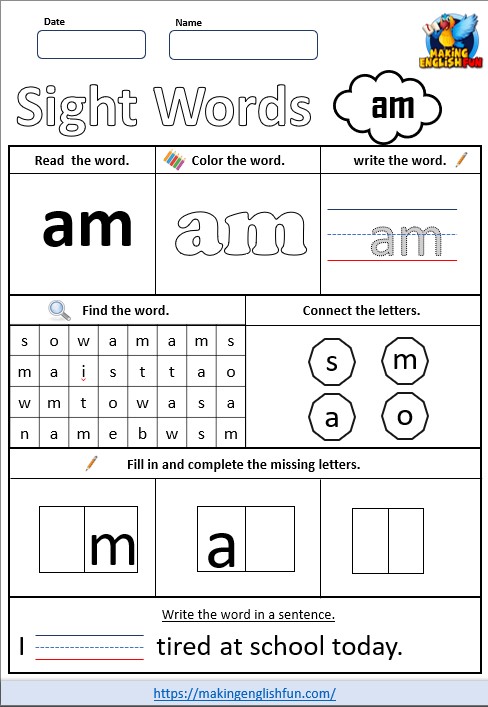
FREE Printable Kindergarten Sight Word Worksheet – “Am”
The sight word “am” is foundational for Kindergarten students, representing the first person singular present tense of “to be.” This guide, developed for educators, ESL instructors, and parents, offers a printable worksheet designed to help children master “am,” thereby enriching their ability to discuss their own state of being, feelings, and actions in the present…
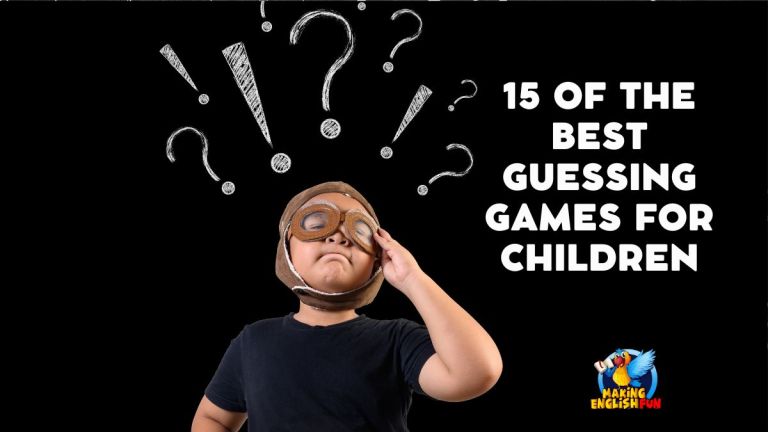
15 Guessing Games For Children and Students
Guessing games are not just fun-filled activities; they are powerful tools in a child’s learning and development journey. From enhancing vocabulary and problem-solving skills to sparking creativity and social interaction, these games offer a load of benefits. In this article, we’ll explore 15 guessing games, including classics like Charades and Pictionary, along with some innovative…

How Often Should Phonics Be Taught to Children?
Phonics skills are an acquired language skill that takes both time and practice to master. Teaching 10-15 minutes a day of dedicated phonics is optimal.
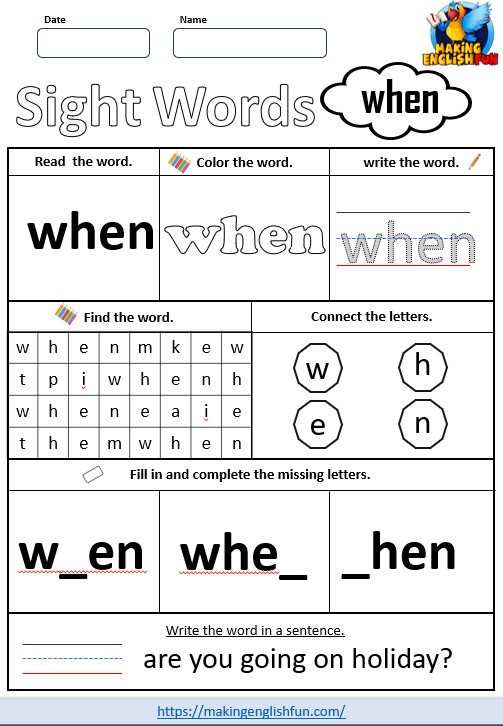
FREE Printable Grade 1 Sight Word Worksheet – “When”
The sight word “when” is pivotal for Grade 1 students, denoting a term used to inquire about or specify a time or occasion. This guide, tailored for educators, ESL instructors, and parents, offers a printable worksheet designed to help children master “when,” thereby enriching their ability to discuss temporal aspects, sequence of events, and historical…

What is the Past Tense of Go
Along with words like “do” and “make”, the verb “to go” in English is among the most useful and important for learners to master. Not only does this word appear incredibly often as a stand-alone verb, but also as part of many phrasal verbs. It’s a must-have verb that no learner can do without. The…

When do Adverbs end in ly?
During my years of delving into the intricacies of the English language, one query continuously surfaced – When do adverbs end in ‘ly’?. This seemingly innocent question is a veritable rabbit hole, full of linguistic twists and turns, perfect for those with an insatiable curiosity for language Adverbs typically end in “ly” when they’re derived…
Always welcome thoughts and comments, new blogs can be lonely!! Cancel reply
Check out our Premium Products in the shop today Dismiss
Discover more from Making English Fun
Subscribe now to keep reading and get access to the full archive.
Continue reading
You must be logged in to post a comment.

Creative Composing: A Lesson Plan for Students, Teachers, and Teacher-Writers

Peitho Volume 26 Issue 1, Fall 2023
Author(s): Meg Scott-Copses
Meg Scott-Copses specializes in creative writing, composition, and an embodied pedagogy that fuses the two. She earned her Ph.D. in poetry from Florida State with a dissertation on service learning in at-risk environments such as prisons and youth shelters. At her home institution, the College of Charleston, she specializes in composition and writing studies, and is the Director of the First-Year Writing program. In 2020, she won the University’s Distinguished Teaching Award, in part based on her research into experiential and embodied teaching practices. She challenges students to explore the intuitive connection between experiential observation and analysis, and between creative and critical thinking.

Introduction
This lesson plan focuses specifically on Wendy Bishop’s chapter “When All Writing is Creative and Student Writing is Literature,” from The Subject is Writing , 2nd edition. Like so much of Bishop’s work, her style and structure serve as direct evidence for her primary argument. She “creatively composes” this chapter, demonstrating the natural overlap between creative and academic pursuits and between student writing and the literature we teach. While Bishop’s work predates the subject we now call rhetorical feminism, she offers a clear example of its key tenets—inclusivity, community, and equity. She privileges dialogue over monologue, inviting students to draw on their own experiences as they develop an empowered and growth-oriented writing practice.
It was long after my graduate training at Florida State that I found language for the re-orientation that Wendy instilled in me. In reading Carolyn Shrewsbury’s “What is Feminist Pedagogy?” and later Cheryl Glenn’s “Remapping Rhetorical Territory,” I came to recognize that my teaching practice moved in these same directions and that I had been guided by Wendy to radically alter the power dynamics and the communication opportunities in my writing classroom. In Shrewsbury’s words, I had created, somewhat unconsciously, a “liberatory environment,” which she describes as:
A classroom characterized as persons connected in a net of relationships…in which we, teacher-student and student-teacher, act as subjects, not objects. Feminist pedagogy is engaged teaching/learning—engaged with self in continuing reflective process; engaged actively with the material being studied; engaged with others in a struggle to get beyond destructive hatreds and to work together to enhance our knowledge; engaged with the community and with movements for social change (166).
Reading any of Wendy’s work reveals these same values as she challenges us to re-orient our understanding of what an academic article is and does. Her chapter “When All Writing is Literature and Student Writing is Creative” offers a clear example of what we might call a “flipped article” (again Wendy’s pedagogy and scholarship was well before the term flipped classroom came into popularity). Readers are immediately inside the experience of her pedagogy, as she places her students’ writing alongside her own. She fuses pedagogical research with lived experience, insisting on a more embodied approach. As for methodology in both creative writing and composition classrooms, she suggests:
Writing always involves the study of exemplary or expert writing in the forms you hope to learn. But you also need the opportunity to write against and experiment with those forms. You have to try it to do it (Bishop 197).
The following lesson plan grows out of this “Try-It” spirit, both for students and for teachers. Recently a colleague asked me about building rapport; he lamented that the buzzwords all sound good in theory—“experiential” “embodied” “hands-on,” “active.” His question: but how do you actually do it? My answer: Not unlike writing, teaching is also about trying it. You have to try it to do it.
Background and Audience
This lesson is appropriate for any of the following courses: Introduction to Academic Writing, First-Year Seminar, Freshman Composition I or II, Introduction to Creative Writing, Introduction to Literary or English Studies, Advanced Composition, Theories of Teaching Writing, Graduate Teaching in English or English Education. Students should come to class having read the article “When All Writing is Creative and Student Writing is Literature,” but even if they haven’t prepared as thoroughly as we’d like, this assignment is designed to experientially teach the key findings of the article and to generate helpful discussions about thinking and writing.
- To understand existing distinctions between disciplinary fields of creative writing, literature, and composition.
- To generate new, experience-based definitions of creative writing, analytical writing, professional writing, and academic writing
- To consider what separates student writing from literature
- To study our own writing preferences, beliefs, and practices
- To discuss helpful teaching and learning strategies for writing
Discussion and Mapping 10-15 minutes
Create binaries on a whiteboard, smartboard, or overhead using the terms Creative Writing vs. Academic Writing and Student Writing vs. Literature. Ask the class to generate key words and associations that typically fall under each heading, as seen below:
Creative Writing /Academic Writing Student Writing / Literature
Discuss areas of overlap between these divisions. For example, both student writing and literature might be published. Both creative writing and academic writing may involve research. Consider what Bishop’s article adds to this discussion. For example, both creative and academic writing are process-based. Both student writing and literature involve an understanding of generic conventions. In Bishop’s view, risk-taking and engagement apply equally to creative and critical thinking.
Two Writing Prompts 20-25 minutes
Divide the class into two groups, A and B, and assign two different quotations (below), both of which are lines from Bishop’s article. Students should begin with this line. Note: students aren’t quoting Bishop (or Bishop’s students); they are acting as though this is their own opening line.
- Group A opening line: Is creative writing stuff that you do for fun and composition stuff that your teacher makes you do? That’s how it felt in elementary school.
- Group B opening line: Creativity involves risk taking. It’s likely that in your past, you were not praised for taking risks.
Subdivide these two groups further so that:
- Group A-Academic will use opening line A to write an academic/analytical piece .
- Group A-Creative will use opening line A to write a creative piece .
- Group B-Academic will use opening line B to write an academic/analytical piece.
- Group B-Creative will use opening line B to write a creative piece.
Allow 7-10 minutes for this first writing prompt. Make sure students understand that this is an exercise, a first try, and that they may not be finished when time is called. The purpose is to see what we know intuitively about these genres and to notice our own thinking and writing process as we try it out.
After time is called for Prompt 1, explain that students will now use the same opening line, but this time to write in the other genre. For example, students who first worked on a creative piece will now use the same line to write something more academic or analytically driven. Allow 7-10 minutes for the other genre.
Partner Work and Class Discussion 20 minutes
Pair students with a partner to discuss this experiment. Ideally, a student from A-Academic should pair with a student from B-Creative. This will offer students a chance to learn more about the opening line they weren’t assigned. It will also control for variables such as which genre they worked on first or second. Students should trade their writing or read what they’ve written aloud, then discuss their process. Which piece felt more successful? Which one surprised you the most? Students might also identify new ideas or emerging definitions for the thinking processes used in each. It’s unlikely that this discussion will need much prompting. In my experience, this portion of class is extremely lively.
Finish class by returning to the charts made at the beginning. What new ideas have developed as a result of this experiential lesson? Assign a reflective follow-up to be completed as homework. Students may post to an online discussion board or bring their reflections to the next class.
Teacher Reflection and Follow-Up Instructions:
As I hinted above, this lesson was a big hit. I knew it would be interactive and hoped it would help students grasp the article, but it far exceeded these expectations. Students were completely engaged in what Bishop describes as the “messy, generative, exciting process of writing” (194). For whatever reason, this particular line has stayed with me years beyond graduate school. I’ve even used this quote on syllabi and assignments, and it came to me again—almost in a chill-bumps way—while watching my students so completely immersed in the act of discovery. The messy, generative, exciting process of writing . Yes!
As good as I felt about the class, I was even more impressed with students’ follow-up posts, which they submitted a few days later. Reflecting on this distilled experience proved to be as important for them as the experience itself. I will insert, here, the prompt I used. In keeping with my earlier theft of Wendy’s lines, please feel free to steal:
- In Thursday’s class, we used the same prompt to write two entries—one creative, one analytical. What did you discover about your own writing through this experience? What takeaways did you glean from your partner in follow-up discussion? Describe your relative comfort with one style over (or in tandem with) another and consider Bishop’s claim that “all writing is creative.”
- After processing your experience, think about what these ideas mean in the context of teaching writing. What’s the role of “the creative” in composition classes? What’s the benefit of considering “student writing” alongside “literature?”
Student Writing
It seems only fitting to focus now on student responses as valuable testimonials and direct evidence for Wendy Bishop’s vision. More than anything else I learned from her, it’s that teaching writing really means writing alongside your students , reading them, letting them read you, learning from them as equally as they learn from you. When I think about recent discussions I’ve had with colleagues and students about the advent of ChatGPT, I take comfort in writing that feels authentic, metacognitive, collaborative, and instructive.
Below, I’ve excerpted passages from students (used with permission) that have given me plenty to think about. These students will be delighted to learn that their writing—not unlike literature—was published, and that their words are worthy of study.
From the unlikely English major:
Bishop’s article discusses the problem of students believing that they aren’t worthy to be named a “writer,” that what they write is so much less than “literature.” The constraints students often face when interacting with academic writing, such as research papers and essays, disregard writing as a creative process. This resonated personally with me as I would’ve never guessed in a million years I would be an English major. Growing up, I enjoyed reading and writing, but never excelled in school. I wasn’t a great essay writer, and I never did anything that deserved praise. I accepted my place outside of the discipline. But I finally had a teacher who encouraged us to take risks and encouraged us to lean into the discomfort we felt and do some exploring. He treated us as if we were all equably capable of producing publishable work. I started reading more, writing more, and caring more, and here I am. —Eliza
From a self-professed analytical writer:
In Thursday’s class, I came to the realization that I really need to get out of my comfort zone when it comes to writing. I naturally gravitate towards writing in a manner that seems academically correct—always. I was assigned to write creatively first, which I really struggled with. Without realizing, I wrote the creative prompt in a more analytical manner. Honestly, I don’t think I wrote creatively at all. And then afterward, when writing analytically, I just used more professional verbiage and somehow making things even more structured than before. Am I really this boring? When discussing with my partner, I noticed that she took a more anecdotal approach, which I think made her text seem less analytical and created a distinction between the two styles. Her writing was fun, personable, and relatable. I noticed that my writing seemed to only answer the prompt. I learned a lot about potential areas for growth. —Chelsea
From an unabashed creative writer:
Reading my creative piece and then moving to my analysis is a bit funny, honestly. It’s like I turned around, put a suit and tie on, slicked my hair back, and turned back to face the audience, ready to lay out some facts and cite some quotes. Lewie and I had a blast conversing and focused mostly on how similar we are in our inability to hush our creativity, humor, and emotion under any circumstances. We never actually read our analyses to each other because we were too busy laughing about how we both wrote intensely dramatic, poetic pieces about risk-taking and creative writing itself. Needless to say, we were both fully immersed —Luca
From students who cultivate the merging of these styles, or who use one genre to think strategically about the other:
From Thursday’s class I learned that I have become a better analytical writer than a creative writer. It was kind of sad to realize this, since I fell in love with writing through the creative writing I did in elementary school. In middle and high school, I still loved creating stories and new approaches with the prompts I was given, and I realize now that this made me a better analytical writer because I would look at these boring papers and still try finding a way to be creative! I think that if students at any level were allowed to release some sort of inner creativity, or allowed their own spin, that both their creative and analytical writing would improve. —Elizabeth
This exercise got me thinking that creative writing and academic writing have a systematic relationship, not a hierarchical one. When we colloquially talk of creative versus academic, we are more speaking about the Inspirational Process versus the Mechanical Process of writing, both in the actual crafting of language and in the crafting of ideas: the fundamental systems employed by the writer. The Inspirational/Mechanical Processes are more akin to energy sources than anything else, and the writer bounces between them whether writing a post, a school essay, a poem, or a novel. The writer uses the Mechanical Process while integrating quotes but may draw on the Inspirational Process when their integration becomes ineffective or repetitive: they dive into the creative energy to find a new, more unexpected way to craft the language and ideas surrounding this quote. When the movement between these two processes is unconscious and fluid, we feel in the zone. When it’s not fluid, we become conscious of the discrepancy and may feel writer’s block. —Jacob
The exercise we did in Thursday’s class was a surprising challenge. I noticed that writing in separate styles forced me to look at the same topic from more than one angle and with different audiences in mind. In talking to Hailey about this experience, we agreed that it was difficult to mentally switch between the analyzing and creative parts of our minds. I can see that this is a skill writers need to practice in order to weave the two aspects together in a singular piece of writing. This experience showed me that academic writing and creative writing really shouldn’t be taught as completely separate entities. It would be a disservice to student writers to not be allowed to start experimenting with the mixture of analysis and creativity before they get to the college level. It would be like parents who don’t let their children cook or try out spicing their own food and exploring flavors. They wonder why kids end up only cooking bland dishes once they move out of the house. Bishop mentions that “creativity involves risk-taking.” What better place for student writers to take risks and try new things with their writing than the classroom? What is a teacher really doing for their students if they don’t foster a safe environment for that? How can a student confidently mix ingredients in new ways if their work keeps coming back to them covered in scolding remarks about criteria and convention errors? —Vaccarella
From students who plan to teach:
I want to be a teacher who praises/encourages students to take risks! I remember what it felt like once when a teacher told me I clearly didn’t get it, and that I should “try something easier.” I had an idea, and though it wasn’t perfect, all ideas deserve attention in a writing class, even if you end up throwing it out because that is part of the writing process too. —Sarah
Rather than thinking of the two as separate categories, Bishop believes one should come before the other: “If you are creative before you are careful, you will be more likely to gain an understanding of the writing process of professionals.” I think this shows the importance of maintaining “the creative” in composition when teaching writing to students. When students are taught to write in a strict, rubric-driven way, they’re being shielded from taking the risks that could make them really grow as writers and invest in the process itself, which most of them come to dread. This activity felt empowering, and I was energized by knowing that it was up to me to feel what was working. I want my future students to use their own instincts. —Ariel
So in teaching writing, maybe teachers should stop giving out super in-depth rubrics and prompts. Let the student read the prompt and use their writing to give the prompt some shape and depth. That way, the teacher may get a new insight instead of receiving what they already know, what they expect, the answers teachers are looking for. —Kennedy
From a rule-breaker:
Ummm…through my experience with responding to the same prompt creatively and analytically, I discovered I need to read prompts more closely. But no matter my oversight, I discovered that I will make any writing prompt my own. Even when I realized I was supposed to be writing something analytical and then something creative, both of my responses took the same form. They failed to be either specifically creative or specifically analytical and became instead what I wanted to write. I even struggled to stay on the topic of creativity, instead finding myself connecting the prompt to some recent experiences. Neither struck me as easier, considering I found it impossible to meet the criteria of both! The other day I saw a TikTok about how at 5 years old 98% of children met the requirements of being a “creative genius.” By age 10, only about 30% did and by adulthood it was less than 5% (or something.) I think the role of creativity in teaching writing should be fostered. There are also many reasons to consider student writing as literature beyond the fact that they are far more similar than they are different. The most compelling to me is building the confidence of students. Regardless of what a teacher may say to their students, their underlying beliefs come through, and if it’s clear that a teacher doesn’t take their students’ writing seriously, students won’t take their own writing seriously either. —Mo
From a student with big questions about academic voice:
It was easier to get into a state of flow when writing creatively. I got nearly three times more words out in the first write-up compared to the second (which I would attribute to the need I felt to incorporate evidence in the academic writing style). It’s interesting that I naturally associate academic writing with evidence-based style and creative writing with a more intuitive style. If I dig further, I realize that the academic voice that I attempted is neither natural or captivating, and it is certainly not a voice that I ever see myself utilizing outside of academia. Why do I use it? Who has shaped my understanding of this academic style… one that I think is both boring and impractical? If you take another step, one must wonder: why do we teach students to write with this voice? I don’t even think this is done intentionally, but I also think this is a bigger question than it appears to be on the surface.—Ryan
Even if you only browsed a few of these student samples, it’s easy to detect their level of engagement. These writers are asking interesting questions and courageously posing solutions for themselves, as well as for the educational systems they are a part of. It’s worth noting that these Discussion Posts are entirely credit-based; students receive a 100 for completion if they meet a 250-word count. All students easily wrote much more than this, not simply checking a box to receive a grade. They continued to mention the impact of this assignment all semester long, even referencing it in final projects and on course-instructor evaluations.
Thank you, Ryan, Mo, Kennedy, Ariel, Sarah, Vaccarella, Jacob, Sarah, Elizabeth, Chelsea, Eliza, Luca, and Mo for giving us new ideas about Wendy Bishop’s work and the larger practice of engaged teaching and writing.
Works Cited
Bishop, Wendy. “When All Writing is Creative and Student Writing is Literature.” The Subject Is Writing , 2nd ed. Edited by Wendy Bishop, Heinemann Educational Books, 1999, pp.192-201.
Glenn, Cheryl. “Remapping Rhetorical Territory.” Rhetoric Review , vol. 13, no. 2, 1995, pp. 287–303.
Shrewsbury, Carolyn M. “What Is Feminist Pedagogy?” Women’s Studies Quarterly , vol. 15, no. 3/4, 1987, pp. 6–14.
Share this Article

Free Verse Poetry Writing Unit - 9 low-prep creative poetry activities & lessons

- Google Slides™
Description
Ignite your students' creativity with this engaging Free Verse Poetry Unit. Requiring little or no prep, this unit offers a comprehensive, hands-on approach to exploring the art of writing free verse poetry - and better yet, it’s fun and open-ended, so it’s perfect for all abilities, and for elementary, middle and high school students.
Get Started: Just project the slideshow for your students and engage them in poetry writing! Each poetry writing activity has step-by-step instructions that are easy for students to follow.
Educational Value:
This unit contains an introduction to free verse poetry, and 8 active poetry writing lessons / activities to inspire your students to write poems.
- Develops Literacy Skills : Encourages reading, writing, and critical thinking.
- Enhances Creativity : Promotes imaginative expression without the constraints of traditional poetry forms.
- Flexible Structure : Suitable for various learning environments and adaptable to different teaching styles.
Fun and Engaging Activities
- Poetry Walks : Students observe their surroundings to find inspiration.
- Found Poetry : Create poems from words found in everyday places.
- Blackout Poetry : Transform pages from old books into artistic masterpieces.
- Collage Poetry : Use cut-out words and phrases to form unique poems.
- Book Spine Poetry : Arrange book titles into poetic statements.
- Magnetic Poetry : Interactive online activity to arrange words into poems.
- Heard Poetry : Craft poems from overheard conversations.
Creative Freedom for Students
- No Rules : Students can experiment with form, structure, and content.
- Play with Words : Focus on the visual and auditory impact of poetry.
- Encourage Expression : Praise effort and creativity, not just the final product.
- Introduction : Explains free verse poetry and provides examples.
- Activity Choice : Pick activities based on student interest, level, or convenience.
- Minimal Preparation : Most activities require basic materials like paper, pens, and clipboards.
- Sharing and Display : Foster a sense of community by sharing poems through gallery walks, bulletin boards, or student presentations.
Tips for Success
- Make It Fun : Encourage playful and humorous ideas.
- Praise Efforts : Focus on the creative process rather than perfect outcomes.
- Continuous Writing : Encourage students to keep adding and refining their poems.
This hands-on, open-ended, and creative resource is so easy for teachers to implement.
Click View Preview to see more!
You may also like:
- IB Learner Profile BUNDLE - 10 Slideshows with activities for all 10 Learner Profile Attributes
- IB PYP Key Concepts Mini-Units
- IB Learner Profile Blank Posters
- IB Learner Profile SONGS
- Spelling - How Spelling Works: Lessons and Posters
- Inquiry Homework and Parent Letter - Your Homework is 'Choose Your Homework'
- Creative Thinking - Open-Ended Tasks
- Songs for Kids - Reading routine songs, Seasonal Songs, and More
- Poems for Beginning Readers
- Fairy Tale Board Games
- Song Parodies and Teacher Editions
- Fun Breaks with Digital Spinners
- Digital Spinner Early Language Games
- Digital Spinner Math Games
- Back to School
Follow Me if you'd like to receive updates when I add new products!
As a 23-year veteran International School IB PYP teacher, librarian, former PYP Coordinator and School Visit Team Member, I focus on creating resources that are hands-on, open-ended, inquiry-based, easy for teachers, and engaging for kids!
All rights reserved by author. For Single Classroom/Single Teacher Use Only.
_______________________________
For more hands-on resources, Visit my TpT Store: HOTLIB
Did You Know ?
When you write a review on your TpT purchases, you earn FREE TpT credits!
Go to your 'My Purchases' page and click on 'Leave a Review'. Every time you write a review, TpT gives you credits you can use for future purchases.
Questions & Answers
- We're hiring
- Help & FAQ
- Privacy policy
- Student privacy
- Terms of service
- Tell us what you think
- International
- Schools directory
- Resources Jobs Schools directory News Search

The Veldt Post-Reading Creative Writing Prompts
Subject: English
Age range: 11-14
Resource type: Worksheet/Activity
Last updated
26 May 2024
- Share through email
- Share through twitter
- Share through linkedin
- Share through facebook
- Share through pinterest

Enhance your The Veldt lesson plans with these captivating and thought-provoking creative writing prompts. Ideal for a variety of class activities, including starter tasks, homework assignments, writing assessments, and substitute teacher lessons, these prompts will challenge your students to explore the characters, themes, and concepts presented in the short story. With a focus on topics such as technology, human nature, and the dangers of an over reliance on technology, these prompts encourage critical thinking and imaginative writing.
The download includes the following: ★ A list of all 10 prompts ★ Individual handouts for each prompt on which students can plan or write their creative pieces.
Some examples of the prompts are: ➤ Write a diary entry from the perspective of either George or Lydia. In the diary entry, you should explore their growing concern about the nursery and their children’s interest in it. ➤ Imagine you are the child psychologist, David McClean and write a report about the behaviour of the Hadley children, their relationship with their parents and your recommended course of action.
Due to the variety of prompts, students can choose their own challenge or you can assign it to them based on their skill level. Don’t miss out on this invaluable resource for teaching Ray Bradbury’s The Veldt in your English classroom. These writing prompts are sure to engage your students and help them delve deeper into the themes and ideas presented in the story.
Tes paid licence How can I reuse this?
Get this resource as part of a bundle and save up to 45%
A bundle is a package of resources grouped together to teach a particular topic, or a series of lessons, in one place.
The Veldt by Ray Bradybury Activities Bundle
Dive into the immersive world of Ray Bradbury's "The Veldt" with our teaching bundle! Elevate your classroom experience with a bundle that goes beyond the ordinary. Our "The Veldt" teaching bundle is curated to deepen understanding and foster engagement. Bursting with interactive activities, it brings the story to life, enriching students' appreciation for its themes, characters, and symbolism. Take your English classroom to new heights with this essential resource! Currently, this bundle includes: ★ The Veldt Post-Reading Creative Narrative Writing Prompts ★ The Veldt Word Search ★ The Veldt Crossword ★ The Veldt Post-Reading Creative Task ★ The Veldt Roll the Dice Discussion Board ★ The Veldt Bingo Review Game
Your rating is required to reflect your happiness.
It's good to leave some feedback.
Something went wrong, please try again later.
This resource hasn't been reviewed yet
To ensure quality for our reviews, only customers who have purchased this resource can review it
Report this resource to let us know if it violates our terms and conditions. Our customer service team will review your report and will be in touch.
LESSON PLAN FOR ENGLISH TEACHERS
Writing a story.

Level: Pre-intermediate (A2-B1)
Type of English: General English
Tags: agreeing and disagreeing storytelling first conditional Vocabulary and grammar
Publication date: 05/17/2021
Students exercise their imagination by predicting the content of four stories which they will encounter later in the lesson. They read a story and identify some of its key grammatical features before considering how stories which are written for exams are marked. They then gain some practice in using these features before planning and writing a story of their own. There is also a short optional exercise related to the key word story. Some exercises in the lesson review language points from units 13-22 of the course plan, but the lesson plan can also stand alone. It also supports students who are preparing for the Cambridge B1 Preliminary exam.
by Stephanie Hirschman
Be the first to share your thoughts on this lesson
Leave a Comment
Student worksheet
Teacher lesson plan
Save lesson to
Students exercise their imagination by predicting the content of four stories which they will encounter later in the lesson. They read a story and identify some of its key grammatical features before considering how stories that are written for exams are marked. They then gain some practice in using these features before planning and writing a story of their own. There is also a short optional exercise related to the key word story. Some exercises in the lesson review language points from units 13-22 of the course plan, but the lesson plan can also stand alone. It also supports students who are preparing for the Cambridge B1 Preliminary Exam.
COURSE PLANS
This comprehensive course plan covers the full range of language needs – listening, role play, vocabulary development.
Worksheets in English for Life course plan
Type of English: General English Level: Pre-intermediate (A2-B1)
Make your lessons unforgettable
Did you know that your students can review the target language from our worksheets with our Expemo flashcard app? To let your student know, just enter their email address below (multiple emails can be separated with a comma).

IMAGES
VIDEO
COMMENTS
First, please remember that any teacher can use these creative writing lessons. You don't need to be teaching homeschoolers. You can be a classroom teacher or a homeschool teacher at home with one student. You can even be a librarian who needs a fun program series. Second, I used these creative writing lesson plans with upper elementary ...
An easy lesson plan for creative writing that will pay off later is to activate prior knowledge. Brainstorm creative, memorable, unforgettable stories with students. Share your thoughts too! You will start to build relationships with students who share the same tastes as you (and those that are completely different!).
Dive into a spooky-type short story and character analysiswith "The Most Dangerous Game.". "Most Dangerous Game" Character Analysis Workbookfrom Teach BeTween the Lines. MAKER SPACE. This creative lesson to inspire secondary writers is a newer approach. Turn your writer's workshop into a maker spacewith these unique ideas from Spark ...
The "I Remember" Poem. Students use personal experience to write creatively in this poetry lesson plan. They'll think back and choose a dozen…. Subjects: Reading and Literature. Poetry. Creative Writing. Download. Add to Favorites.
Creative Writing Lesson Plans. This indicates resources located on The Teacher's Corner. Start a Story Grades Various. Help students with creative writing. Pull several desks into a circle (4-7 students works well). Each student gets a blank sheet of paper and pencil. Thee put their name on the back of their paper.
Here are 10 of our favorite story telling activities that inspire students: 1. Write an "I am from" poem. Students read the poem "I am From" by George Ella Lyon. Then, they draft a poem about their own identity in the same format Lyon used. Finally, students create a video to publish their poems.
They learn to write for an audience. Reading their writing aloud strengthens their understanding of the written word. Enjoy the following links as you develop creative writing lesson plans for a variety of writing modes: narrative, persuasive, expository, and descriptive. May your classroom creative writing community sparkle and shine:
Here are five lesson plans from the 2022-2023 school year for middle and high school students, from our Writing the Community teaching artists!. A Poem About Joy: In this lesson plan, inspired by Ross Gay's "Sorrow Is Not My Name," Teré Fowler-Chapman asks young poets to come up with a list of things that bring them joy and then write a poem inspired by one of the items on that list.
Overview. To promote development, detail, and focus of ideas in students' writing, it sometimes helps to start with a fun, creative writing activity that encourages what you want to see in all of their writing. In this minilesson, students practice writing detailed, sensory-rich descriptions by framing a small piece of nature and freewriting ...
1. Education.com offers creative writing lesson plans to kids of all ages. Teachers will find our lesson plans spark their classroom's imagination into artistic storytelling and writing. Our lesson plans are all purposefully themed so children can think outside the box when applying creative writing concepts. Don't delay the creativity - start now!
8. Out of a Hat. Teach your students about the components of different literary forms by discussing writing styles (narrative, expository, descriptive, and persuasive). Write each form on a small piece of paper and, you guessed it, toss it in a hat (or a bucket or any type of container).
Creative Writing Lesson Plan. Dana teaches social sciences at the college level and English and psychology at the high school level. She has master's degrees in applied, clinical and community ...
Keep your class engaged with our creative writing lesson plans! Discover interactive lessons that encourage imagination and self-expression, crucial skills for effective writing. Help students write stories, poems, thank-you notes, and more such creative stuff! With clear learning objectives, fun writin...
6 Ways to Teach Writing reatively Teach your students the fun aspects of writing. Students of all ages write short stories and papers, from younger elementary-school writers through college-age students.
Overview. Wordless picture books offer a wonderful foundation for creative writing. Often, students struggle with ideas and topics for writing. This genre of books offers a platform for students to develop their writing skills. In this lesson, students are exposed to wordless picture books and begin developing story lines orally and in writing.
This 37-page document is designed for writers of novels, but many of the tips apply equally to writers of short stories. Clear, simple, and easy to read, appropriate for 5th or 6th grade (in places) and up. Adobe Reader required for access. Students write a line of poetry in response to something the teacher reads.
Creative writing lesson ideas for children aged 7-8. Children from ages 7-8 will have expanded their vocabulary significantly and begin to understand some complex literary devices such as metaphors, similes, and double entendres. They'll also be mature enough to understand structural devices like paragraphs. Begin your creative writing lesson ...
Here's How to Teach a Creative Writing Activity to Elementary Students: 1. Start with Creative Writing Prompts. One of the first activities you can try is using writing prompts with students. Writing prompts are a great tool to get students' brain juices flowing, no matter if they are elementary, middle school, or high school students!
Creative Writing Lesson Plans. April 15, 2020 / Writing. Creative writing is an important writing style for students to learn about and experience on their journey to becoming writers. Helping students embrace their creativity is a great way to get students writing. Students enjoy writing more when they get choice over their topic and format.
Skill Builders: Word Analogy Questions, Week 29. Week 29: Word analogies to sharpen students' thinking skills and prepare them for standardized tests. Browse our printable 7th Grade Creative Writing Lesson Plans resources for your classroom. Download free today!
Created by. Ashley Johnson. This Informative and Explanatory Paragraph Writing freebie is a sample of my 300+ paged Informative and Explanatory Paragraph Writing unit. It is a great way to introduce and give your students practice writing informative and explanatory paragraphs. The unit is aligned with the Common Core Standards grades K-3.
Tips for Using Prompts: Be Open-Minded: Don't limit yourself to the first idea that comes to mind. Explore different angles and perspectives. Stay Consistent: Use prompts regularly to build a writing habit. Even short, daily writing sessions can be beneficial. Combine Prompts: Mix and match different prompts to create more complex and ...
Creative Composing: A Lesson Plan for Students, Teachers, and Teacher-Writers. Peitho Volume 26 Issue 1, Fall 2023. Author(s): Meg Scott-Copses Meg Scott-Copses specializes in creative writing, composition, and an embodied pedagogy that fuses the two. She earned her Ph.D. in poetry from Florida State with a dissertation on service learning in at-risk environments such as prisons and youth ...
Browse Middle School Writing Lesson Plans. Award winning educational materials designed to help kids succeed. Start for free now! ... They will use a graphic organizer to organize their ideas and sort their research notes into meaningful sections. 6th grade. ... Lesson Plan. 1. Educational Tools. Learning Library; Worksheets; Games; Interactive ...
Educational Value: This unit contains an introduction to free verse poetry, and 8 active poetry writing lessons / activities to inspire your students to write poems. Develops Literacy Skills: Encourages reading, writing, and critical thinking. Enhances Creativity: Promotes imaginative expression without the constraints of traditional poetry forms.
Closing Date: Thursday 1st Jan 1970. Competition Terms & Conditions. We run poetry and creative writing competitions throughout the year for Primary and Secondary Schools in the UK and USA. Let's make writing fun!
Enhance your The Veldt lesson plans with these captivating and thought-provoking creative writing prompts. Ideal for a variety of class activities, including starter tasks, homework assignments, writing assessments, and substitute teacher lessons, these prompts will challenge your students to explore the characters, themes, and concepts presented in the short story.
But, creative writing can also be in the form of poetry, scripts, or fictional biographies. Creative writing lesson ideas for children aged 4-5. It's never too early to introduce children to the wonderful world of creative writing! Even though children around this age are still learning how to write, it's a great idea to teach them the ...
There is also a short optional exercise related to the key word story. Some exercises in the lesson review language points from units 13-22 of the course plan, but the lesson plan can also stand alone. It also supports students who are preparing for the Cambridge B1 Preliminary Exam. by Stephanie Hirschman. Student worksheet. Teacher lesson plan.
A lesson plan is a teacher's detailed description of the course of instruction or "learning trajectory" for a lesson.A daily lesson plan is developed by a teacher to guide class learning. Details will vary depending on the preference of the teacher, subject being covered, and the needs of the students.There may be requirements mandated by the school system regarding the plan.